-
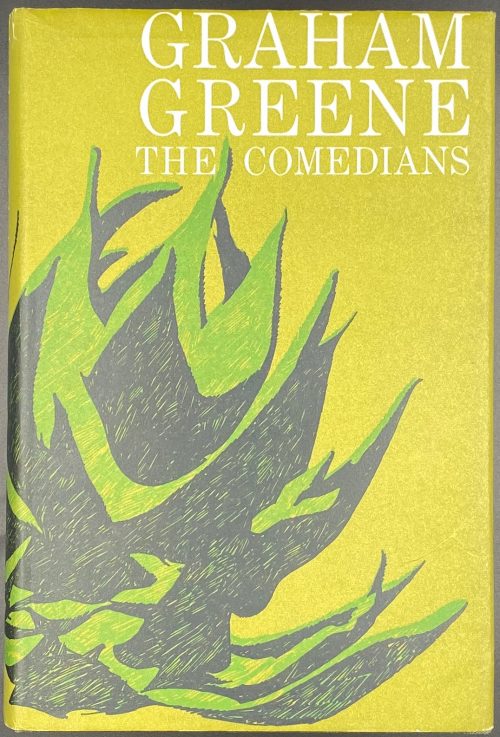 DJ: Graham Greene | THE COMEDIANS || Title page: THE COMEDIANS | Graham Greene | {four lines citation from Thomas Hardy} | {publisher’s device} | THE BODLEY HEAD| LONDON || Edition: 1st edition, 1st printing. Binding: bound in green cloth, 20.5 x 13.5 cm, with gilt lettering to spine, in green pictorial dust jacket with white lettering, price clipped; gift autograph to fep: “To. | Richard | From: gig | Xmas 1964.” (sic., the book was published in 1966!) Pagination: [1-4] 5-313 [314 blank] [6] blanks (total 320 pages). Collation: 16mo; [A]4 B-K16 L12 (total 160 leaves).
DJ: Graham Greene | THE COMEDIANS || Title page: THE COMEDIANS | Graham Greene | {four lines citation from Thomas Hardy} | {publisher’s device} | THE BODLEY HEAD| LONDON || Edition: 1st edition, 1st printing. Binding: bound in green cloth, 20.5 x 13.5 cm, with gilt lettering to spine, in green pictorial dust jacket with white lettering, price clipped; gift autograph to fep: “To. | Richard | From: gig | Xmas 1964.” (sic., the book was published in 1966!) Pagination: [1-4] 5-313 [314 blank] [6] blanks (total 320 pages). Collation: 16mo; [A]4 B-K16 L12 (total 160 leaves). -
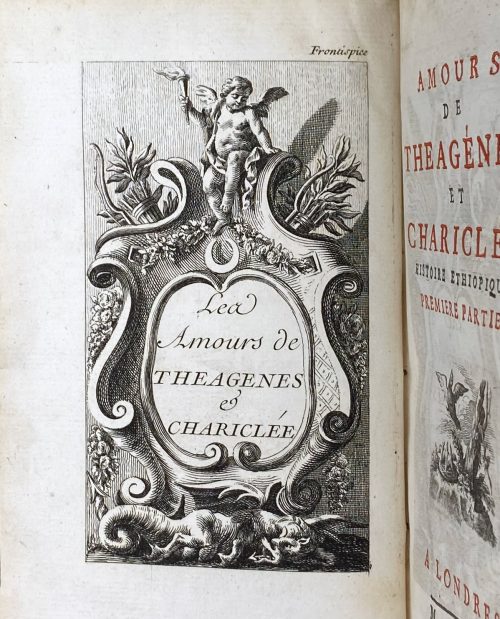 Two volumes in-16o, 16.3 x 10.3 cm, uniformly bound in marbled calf with gilt triple-fillet border, flat spine with gilt lozenges in compartments, two crimson labels with gilt lettering, marbled endpapers, all edges gilt, with engraved title, 2 title vignettes, 11 copper plate engravings, incl. title/frontispiece in vol. 1, and 10 headpieces (two of them similar), printed on laid paper. Vol. 1: Livres 1 – 5. Engraved title-page: Cartouche with the title "Les | Amours de | THEAGENES | & | CHARICLÉE", with a Cupid holding a torch on top and a defeated winged dragon at the bottom; Cupid's quivers with bows and arrows beside. Collation: 8vo; a5 (t.p., preface), A-N8 O4 (O4 blank), total 113 leaves plus 6 unsigned engraved plates, incl. engraved title as frontispiece, unsigned; 5 different headpieces, unsigned. Pagination: [i, ii] iii-x, [1] 2-213 [3] (blank), total 226 pages, ils. Vol. 2: Livres 6 – 10. Collation: 8vo; π1 (t.p.), A-M8, total 97 leaves plus 6 unsigned plates, incl. the Conclusion, no frontispiece; 5 headpieces, the headpiece for Livre 7 similar to Livre 4. Pagination: [2] [1] 2-190 [2] (blank), total 194 pages, ils. Letterpress title-page (red and black) in each volume: AMOURS | DE | THEAGÉNES | ET | CHARICLÉE• | HISTOIRE ETHIOPIQUE. | PREMIERE (SECONDE) PARTIE. | {vignette} | A LONDRES, | — | M. DCC. XLIII. || According to Cohen-DeRicci, this is the first anonymous edition with 9 different headpieces; the second edition in the same 1743 was published by Antoine Urban Coustelier (French, 1714 – 1763) in Paris with less provocative headpiece vignettes. The original text belongs to Héliodore d'Emèse, i.e. Heliodorus [Ἡλιόδωρος] (Greek, 3rd – 4th century AD). The earliest translation into French was performed by Jacques Amyot (French, 1513 – 1593) and published by J. Longis in Paris in 1547. The new translation is credited by Lewine to Jean de Montlyard (French/Swiss, 17th century), first published in Paris in 1620. However, most scholars attribute it to Louis François de Fontenu (French, 1667 – 1759), Bernard Le Bovier de Fontenelle (French, 1657 – 1757) or Germain François Poullain de Saint-Foix (French, 1698 – 1776), first published in 1727 by Herman Uytwerf (Dutch, 1698 – 1754) in Amsterdam. Catalogue raisonné : J. Lewine, 236; Cohen-DeRicci, 478. Information about the story can be found here: Aethiopica.
Two volumes in-16o, 16.3 x 10.3 cm, uniformly bound in marbled calf with gilt triple-fillet border, flat spine with gilt lozenges in compartments, two crimson labels with gilt lettering, marbled endpapers, all edges gilt, with engraved title, 2 title vignettes, 11 copper plate engravings, incl. title/frontispiece in vol. 1, and 10 headpieces (two of them similar), printed on laid paper. Vol. 1: Livres 1 – 5. Engraved title-page: Cartouche with the title "Les | Amours de | THEAGENES | & | CHARICLÉE", with a Cupid holding a torch on top and a defeated winged dragon at the bottom; Cupid's quivers with bows and arrows beside. Collation: 8vo; a5 (t.p., preface), A-N8 O4 (O4 blank), total 113 leaves plus 6 unsigned engraved plates, incl. engraved title as frontispiece, unsigned; 5 different headpieces, unsigned. Pagination: [i, ii] iii-x, [1] 2-213 [3] (blank), total 226 pages, ils. Vol. 2: Livres 6 – 10. Collation: 8vo; π1 (t.p.), A-M8, total 97 leaves plus 6 unsigned plates, incl. the Conclusion, no frontispiece; 5 headpieces, the headpiece for Livre 7 similar to Livre 4. Pagination: [2] [1] 2-190 [2] (blank), total 194 pages, ils. Letterpress title-page (red and black) in each volume: AMOURS | DE | THEAGÉNES | ET | CHARICLÉE• | HISTOIRE ETHIOPIQUE. | PREMIERE (SECONDE) PARTIE. | {vignette} | A LONDRES, | — | M. DCC. XLIII. || According to Cohen-DeRicci, this is the first anonymous edition with 9 different headpieces; the second edition in the same 1743 was published by Antoine Urban Coustelier (French, 1714 – 1763) in Paris with less provocative headpiece vignettes. The original text belongs to Héliodore d'Emèse, i.e. Heliodorus [Ἡλιόδωρος] (Greek, 3rd – 4th century AD). The earliest translation into French was performed by Jacques Amyot (French, 1513 – 1593) and published by J. Longis in Paris in 1547. The new translation is credited by Lewine to Jean de Montlyard (French/Swiss, 17th century), first published in Paris in 1620. However, most scholars attribute it to Louis François de Fontenu (French, 1667 – 1759), Bernard Le Bovier de Fontenelle (French, 1657 – 1757) or Germain François Poullain de Saint-Foix (French, 1698 – 1776), first published in 1727 by Herman Uytwerf (Dutch, 1698 – 1754) in Amsterdam. Catalogue raisonné : J. Lewine, 236; Cohen-DeRicci, 478. Information about the story can be found here: Aethiopica. -
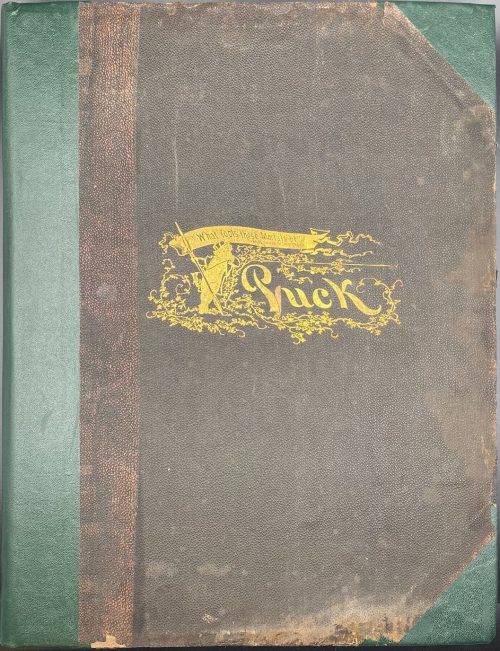 26 issues of American political humourous magazine published by Joseph Keppler (Austrian-American, 1838 – 1894) and Adolph Schwarzmann (German-American, 1838 – 1904) with caricatures by Frederick Burr Opper (American, 1857 – 1937); 35 x 27 cm, bound in faux shagreen with half green buckram backing, gilt vignette and lettering to front board: ‘What fools these Mortals be!” | MIDSUMMER NIGHT'S DREAM | PUCK ||
26 issues of American political humourous magazine published by Joseph Keppler (Austrian-American, 1838 – 1894) and Adolph Schwarzmann (German-American, 1838 – 1904) with caricatures by Frederick Burr Opper (American, 1857 – 1937); 35 x 27 cm, bound in faux shagreen with half green buckram backing, gilt vignette and lettering to front board: ‘What fools these Mortals be!” | MIDSUMMER NIGHT'S DREAM | PUCK || -
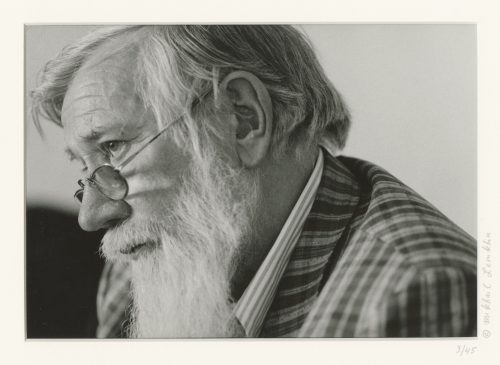 Photographic portrait of writer Andrei Sinyavsky, head and shoulder, turned to the left, wearing glasses. Pencil-signed on the mat: 3/45 • ©Mikhail Lemkhin; on the back of the print: Copyright statement stamp; ink stamp ©MIKHAIL LEMKHIN; ink stamp: PHOTO BY MIKHAIL LEMKHIN | 1811 38TH AVENUE | SAN FRANCISCO, CA 94122 | (415) 664-7677; pencil inscription on the back of the mat: (top) АНДРЕЙ СИНЯВСКИЙ | ANDREI SINYAVSKY, (bottom) XXIX. Sitter: Andrei Sinyavsky [Андрей Донатович Синявский] (Russian, 1925 – 1997) Size: mat: 35.6 x 43.3 cm; window: 16.5 x 23.5 cm; print: 20.2 x 25.2 cm.
Photographic portrait of writer Andrei Sinyavsky, head and shoulder, turned to the left, wearing glasses. Pencil-signed on the mat: 3/45 • ©Mikhail Lemkhin; on the back of the print: Copyright statement stamp; ink stamp ©MIKHAIL LEMKHIN; ink stamp: PHOTO BY MIKHAIL LEMKHIN | 1811 38TH AVENUE | SAN FRANCISCO, CA 94122 | (415) 664-7677; pencil inscription on the back of the mat: (top) АНДРЕЙ СИНЯВСКИЙ | ANDREI SINYAVSKY, (bottom) XXIX. Sitter: Andrei Sinyavsky [Андрей Донатович Синявский] (Russian, 1925 – 1997) Size: mat: 35.6 x 43.3 cm; window: 16.5 x 23.5 cm; print: 20.2 x 25.2 cm. -
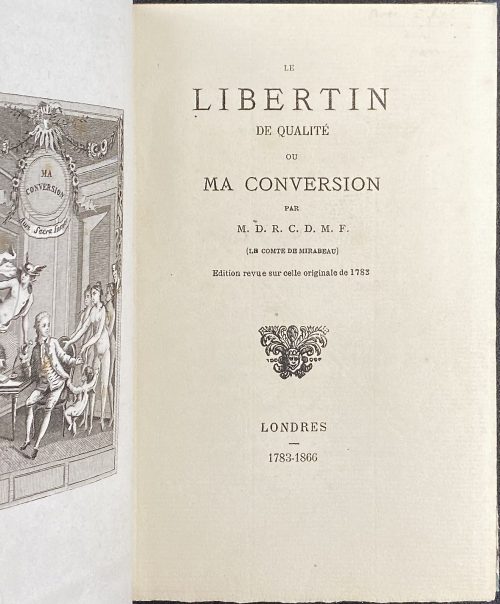 Hardcover volume, 17 x 11.3 cm, in-12, quarter orange cloth (percaline) over marbled boards, black morocco label with gilt lettering to spine, marbled endpapers, text printed on laid paper, five plates on India paper (papier Chine). Title-page: LE | LIBERTIN | DE QUALITÉ | OU | MA CONVERSION | PAR | M. D. R. C. D. M. F. | (LE COMTE DE MIRABEAU) | Edition revue sur celle originale de 1783 | {fleuron} | LONDRES | – | 1783-1866 || Pagination: [4] (h.t., t.p.), [1] 2-200; total 204 pages plus 5 engraved plates, incl. frontispiece; 2 blank leaves at the front and 2 at the back, laid paper, watermarked Canson & Montgolfier. Catalogue raisonné: Dutel I: A-653. Ref.: Illustrations were earlier published in Vie privée, libertine et scandaleuse de feu Honoré-Gabriel Riquetti Comte de Mirabeau, 1791, (see [LIB-2633.2021] Apollinaire, et al. L’Enfer de la Bibliothèque nationale, 1912 : № 795). M. D. R. C. D. M. F stands for Monsieur de Riqueti comte de Mirabeau Fis. Catalogue Poulet-Malassis & ses amis description: № 55. M. D. R. C. D. M. F. (le comte de Mirabeau). Le Libertin de qualité ou Ma conversion, édition revue sur celle de l’originale de 1783. Londres 1783-1866 [Christiaens, 1867]. In-12 de 2 .n.ch. et 200 pages, demi-percaline orange, pièce de titre, tête jaspée, tranches naturelles (reliure de l’époque). Illustré de 5 gravures originales, dont l’une en frontispice, qui reprennent celles de l’édition de Vie privée libertine et scandaleuse de feu Honoré-Gabriel-Riqueti, ci-devant comte de Mirabeau [...] de 1791. Contributors: Honoré-Gabriel Riqueti de Mirabeau (French, 1749 – 1791) – author. Alexis Christiaens (Belgian, d. 1880) – publisher.
Hardcover volume, 17 x 11.3 cm, in-12, quarter orange cloth (percaline) over marbled boards, black morocco label with gilt lettering to spine, marbled endpapers, text printed on laid paper, five plates on India paper (papier Chine). Title-page: LE | LIBERTIN | DE QUALITÉ | OU | MA CONVERSION | PAR | M. D. R. C. D. M. F. | (LE COMTE DE MIRABEAU) | Edition revue sur celle originale de 1783 | {fleuron} | LONDRES | – | 1783-1866 || Pagination: [4] (h.t., t.p.), [1] 2-200; total 204 pages plus 5 engraved plates, incl. frontispiece; 2 blank leaves at the front and 2 at the back, laid paper, watermarked Canson & Montgolfier. Catalogue raisonné: Dutel I: A-653. Ref.: Illustrations were earlier published in Vie privée, libertine et scandaleuse de feu Honoré-Gabriel Riquetti Comte de Mirabeau, 1791, (see [LIB-2633.2021] Apollinaire, et al. L’Enfer de la Bibliothèque nationale, 1912 : № 795). M. D. R. C. D. M. F stands for Monsieur de Riqueti comte de Mirabeau Fis. Catalogue Poulet-Malassis & ses amis description: № 55. M. D. R. C. D. M. F. (le comte de Mirabeau). Le Libertin de qualité ou Ma conversion, édition revue sur celle de l’originale de 1783. Londres 1783-1866 [Christiaens, 1867]. In-12 de 2 .n.ch. et 200 pages, demi-percaline orange, pièce de titre, tête jaspée, tranches naturelles (reliure de l’époque). Illustré de 5 gravures originales, dont l’une en frontispice, qui reprennent celles de l’édition de Vie privée libertine et scandaleuse de feu Honoré-Gabriel-Riqueti, ci-devant comte de Mirabeau [...] de 1791. Contributors: Honoré-Gabriel Riqueti de Mirabeau (French, 1749 – 1791) – author. Alexis Christiaens (Belgian, d. 1880) – publisher. -
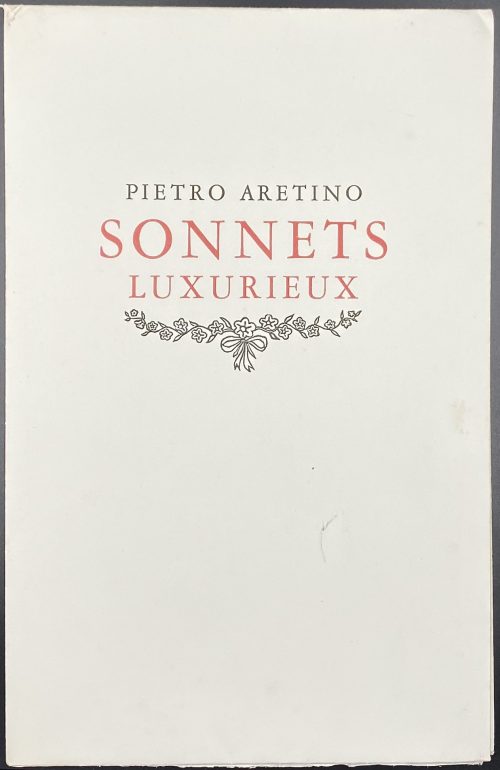 Softcover volume, 25.9 x 16.7 cm, in French flapped wrappers lettered "PIETRO ARETINO | SONNETS | LUXURIEUX | {garland}" unbound, 6 gatherings in 4to (24 leaves, incl. those in wrappers), a few sheets of guard tissue laid in, unpaginated, lower margin untrimmed; in a burgundy double slipcase 26.3 x 17.3 cm. Illustrated with title-page vignette, red initials and tailpieces and 16 half-page engravings by Jean Baptiste Tavy Notton. Text in Italian and French. Title-page (red and black): SONNETS | LUXURIEUX | de | PIETRO ARETINO | dit L'ARÉTIN | avec accompagnement | de gravures au burin | d'après la description des gravures | de GIULIO PIPPI DE GIANNUZZI dit JULES ROMAIN | {vignette} | AUX DÉPENS | DE QUELQUES AMATEURS | 1948 || Clandestine limited edition, print run of 250 copies, of which this is copy № 20, printed on thick wove paper without watermarks. Catalogue raisonné: Dutel III № 2421. Original edition: Sonetti lussuriosi by Pietro Aretino, illustrated by Giulio Romano and engraved by Marcantonio Raimondi, published clandestinely in Venice in c.1527. Contributors: Pietro Aretino (Italian, 1492 – 1556) – author. Jean Baptiste Tavy Notton (French, 1914 – 1971) – artist. Antoine-Isidore Liseux (French, 1835 – 1894) – translator/comments. Giulio Romano [Giulio Pippi, Giulio Giannuzzi] (Italian, c.1499 – 1546) – artist. Marcantonio Raimondi (Italian c. 1470/82 – c. 1534) – engraver.
Softcover volume, 25.9 x 16.7 cm, in French flapped wrappers lettered "PIETRO ARETINO | SONNETS | LUXURIEUX | {garland}" unbound, 6 gatherings in 4to (24 leaves, incl. those in wrappers), a few sheets of guard tissue laid in, unpaginated, lower margin untrimmed; in a burgundy double slipcase 26.3 x 17.3 cm. Illustrated with title-page vignette, red initials and tailpieces and 16 half-page engravings by Jean Baptiste Tavy Notton. Text in Italian and French. Title-page (red and black): SONNETS | LUXURIEUX | de | PIETRO ARETINO | dit L'ARÉTIN | avec accompagnement | de gravures au burin | d'après la description des gravures | de GIULIO PIPPI DE GIANNUZZI dit JULES ROMAIN | {vignette} | AUX DÉPENS | DE QUELQUES AMATEURS | 1948 || Clandestine limited edition, print run of 250 copies, of which this is copy № 20, printed on thick wove paper without watermarks. Catalogue raisonné: Dutel III № 2421. Original edition: Sonetti lussuriosi by Pietro Aretino, illustrated by Giulio Romano and engraved by Marcantonio Raimondi, published clandestinely in Venice in c.1527. Contributors: Pietro Aretino (Italian, 1492 – 1556) – author. Jean Baptiste Tavy Notton (French, 1914 – 1971) – artist. Antoine-Isidore Liseux (French, 1835 – 1894) – translator/comments. Giulio Romano [Giulio Pippi, Giulio Giannuzzi] (Italian, c.1499 – 1546) – artist. Marcantonio Raimondi (Italian c. 1470/82 – c. 1534) – engraver. -
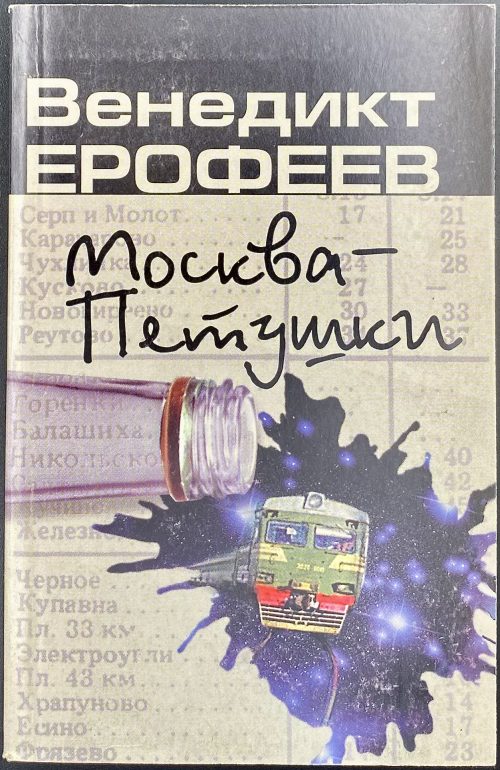 Paperback, 16.5 x 10.8 cm, pictorial wrappers, lettering to front and spine; pp.: [1-4] 5-187 [188] [4]. Title-page: Венедикт | ЕРОФЕЕВ | Москва – | Петушки | ПОЭМА | ВАГРИУС • МОСКВА • 2003 || Print-run: 11,000. Contributors: Венедикт Васильевич Ерофеев [Venedikt Yerofeyev] (Russian, 1938 – 1990) – author. Вагриус – publisher.
Paperback, 16.5 x 10.8 cm, pictorial wrappers, lettering to front and spine; pp.: [1-4] 5-187 [188] [4]. Title-page: Венедикт | ЕРОФЕЕВ | Москва – | Петушки | ПОЭМА | ВАГРИУС • МОСКВА • 2003 || Print-run: 11,000. Contributors: Венедикт Васильевич Ерофеев [Venedikt Yerofeyev] (Russian, 1938 – 1990) – author. Вагриус – publisher. -
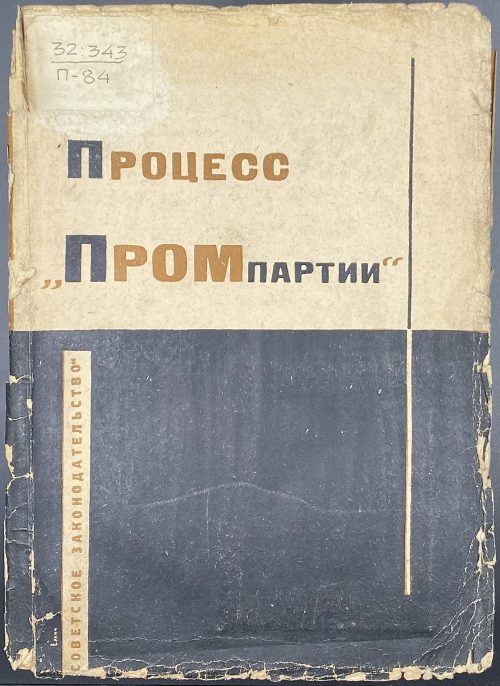 Softcover, 24 x 18 cm, black and white original wrappers, lettering; pp. [1-6] 7-541 [3]; purple ink library stamps and numbers. Title-page: ПРОЦЕСС “ПРОМПАРТИИ” | (25 ноября – 7 декабря 1930 г.) | СТЕНОГРАММА | СУДЕБНОГО ПРОЦЕССА | И МАТЕРИАЛЫ, | ПРИОБЩЕННЫЕ К ДЕЛУ | 1931 | ОГИЗ — “СОВЕТСКОЕ ЗАКОНОДАТЕЛЬСТВО” — МОСКВА || Процесс Промпартии [Industrial Party Trial] Андрей Януарьевич Вышинский [Andrey Vyshinsky] (Russian, 1883 – 1954) – chairman. Николай Васильевич Крыленко [Nikolai Krylenko] (Russian, 1885 – 1938) – public prosecutor.
Softcover, 24 x 18 cm, black and white original wrappers, lettering; pp. [1-6] 7-541 [3]; purple ink library stamps and numbers. Title-page: ПРОЦЕСС “ПРОМПАРТИИ” | (25 ноября – 7 декабря 1930 г.) | СТЕНОГРАММА | СУДЕБНОГО ПРОЦЕССА | И МАТЕРИАЛЫ, | ПРИОБЩЕННЫЕ К ДЕЛУ | 1931 | ОГИЗ — “СОВЕТСКОЕ ЗАКОНОДАТЕЛЬСТВО” — МОСКВА || Процесс Промпартии [Industrial Party Trial] Андрей Януарьевич Вышинский [Andrey Vyshinsky] (Russian, 1883 – 1954) – chairman. Николай Васильевич Крыленко [Nikolai Krylenko] (Russian, 1885 – 1938) – public prosecutor. -
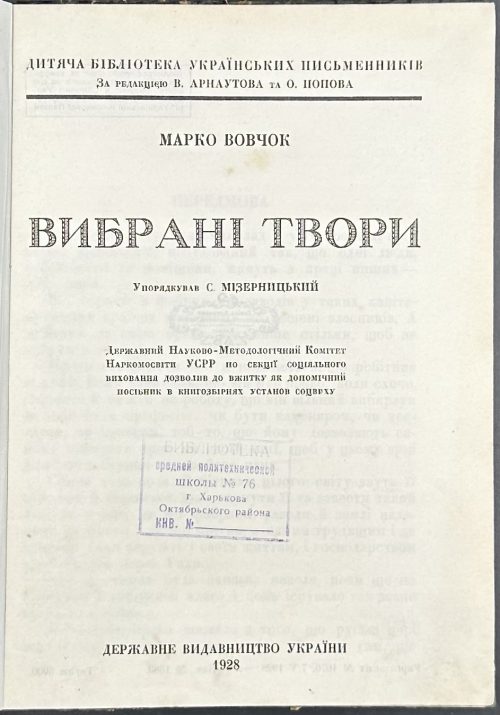 Owner’s quarter cloth over faux marbled paper binding, 19.8 x 15.1 cm, pp.: [1-4] 5-227 [3], total 230 pages plus frontispiece (b/w photographic portrait w/facsimile); library blue ink stamp to t.p. “Библиотека средней политехнической школы № 76 г. Харькова Октябрьского района Инв. № ___». Title-page: ДИТЯЧА БIБЛIОТЕКА УКРАЇНСЬКИХ ПИСЬМЕННИКIВ | За редакцiєю В. АРНАУТОВА та О. ПОПОВА | — | ВИБРАНI ТВОРИ | Упорядкував С. МIЗЕРНИЦЬКИЙ | Державний Науково-Методологiчний Комитет | Наркомосвiти УСРР по секциï сицiяльного | виховання дозволив до вжитку як допомiчний | посiбник в книгозбiрнях установ соцвиху | ДЕРЖАВНЕ ВИДАВНИЦТВО УКРАЇНИ | 1928 || Contents: Передмова, Викуп, Паньска воля (Горпина), Козачка, Ледащиця, Чумак, Не до пари, Тюлева баба, Кармелюк, Гайдамаки. Print run: 5,000 copies. Contributors: Марко Вовчок [Marko Vovchok; Марія Олександрівна Вілінська] (Ukrainian, 1833 – 1907) – author. Other variants: Markowovzok and Marko Vovtchok.
Owner’s quarter cloth over faux marbled paper binding, 19.8 x 15.1 cm, pp.: [1-4] 5-227 [3], total 230 pages plus frontispiece (b/w photographic portrait w/facsimile); library blue ink stamp to t.p. “Библиотека средней политехнической школы № 76 г. Харькова Октябрьского района Инв. № ___». Title-page: ДИТЯЧА БIБЛIОТЕКА УКРАЇНСЬКИХ ПИСЬМЕННИКIВ | За редакцiєю В. АРНАУТОВА та О. ПОПОВА | — | ВИБРАНI ТВОРИ | Упорядкував С. МIЗЕРНИЦЬКИЙ | Державний Науково-Методологiчний Комитет | Наркомосвiти УСРР по секциï сицiяльного | виховання дозволив до вжитку як допомiчний | посiбник в книгозбiрнях установ соцвиху | ДЕРЖАВНЕ ВИДАВНИЦТВО УКРАЇНИ | 1928 || Contents: Передмова, Викуп, Паньска воля (Горпина), Козачка, Ледащиця, Чумак, Не до пари, Тюлева баба, Кармелюк, Гайдамаки. Print run: 5,000 copies. Contributors: Марко Вовчок [Marko Vovchok; Марія Олександрівна Вілінська] (Ukrainian, 1833 – 1907) – author. Other variants: Markowovzok and Marko Vovtchok. -
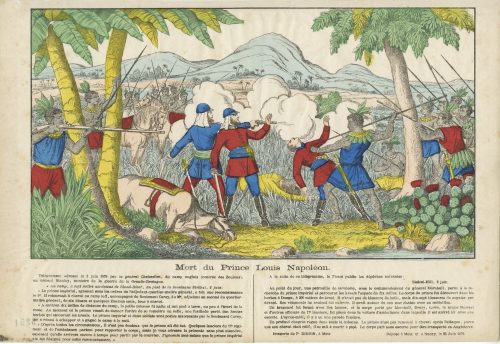 Hand-coloured woodcut on wove paper, 267 x 390 mm. On reverse: black ink stamp “5351”. Centre, under the image frame "Mort du Prince Louis Napoléon". Below left: "Télégramme adressé le 2 juin 1879 par le général Chelmsfort, du camp anglais (contrée des Zoulous), au colonel Stanley, ministre de la guerre de la Grande-Bretagne. « Au camp, à sept milles au-dessus de Blood-River, au pied de la montagne Stellezi, 2 juin: Le prince impérial, agissant sous les ordres de l'adjudant quartier-maitre général. a fait une reconnaissance le 1er. Il retournait à cheval au camp le 2 accompagné du lieutenant Carey, du 98e adjudant en second du quartier-maitre général. de six blancs et, quelques Zoulous amis, tous à cheval. A environ dix milles de distance du camp, la petite colonne fit halte at mit pied à terre, un peu à l’écart de la route. Au moment ou le prince venait de donner l'ordre de se remettre en selle. une fusillade partit des hautes herbes qui entourant les kraals. Le prince impérial et deux soldats sont portés manquants par le lieutenant Carey, qui a réussi à échapper et a gagné le camp à la nuit. D'après toutes les circonstances, il 'est pas douteux quo le prince ait été tué. Quelques lanciers du 17 régiment et de l'ambulance partent pour rapporter le corps; mais je vous adresse la présente sans plus attendre, espérant qu'elle arrivera encore à temps pour partir par le courrier. J’ignorais moi-même que le prince impérial eût été désigné pour cette reconnaissance. »" Below right: A la suite de le télégramme, le Times publie les dépêches suivantes: Stelezi-Hill, 2 juin. Au point du jour, une patrouille de cavalerie, sous le commandement du général Marshall. partit à la recherche du prince impérial et parcourut les kraals l'espace de dix milles. Le corps du prince fut découvert dans les herbes à Donga, à 300 mètres du kraal. Il n'avait pas de blessure de balle, mais dix-sept blessures de zagaies par devant. Ses vêtements lui avaient été enlevés. I avait autour du cou une chaine avec un médaillon. Un brancard fut formé avec les lances, et le corps porté par Marchall, Drury, Lowe, le mjor Stewart et d'autres officiers du 17e lanciers, fut. place dans la voiture d'ambulance dans laquelle il est arrivé ici avec une escorte. L'après-midi, il v a eu une parade funèbre. Un profond chagrin règne dans toute la colonne. Le prince n'est pas remonté à cheval après l’attique, parce que son cheval était rétif ; il se mit à courir à pied. Le corps part sous escorte pour être transporté en Angleterre. Bottom right: "Imagerie de P. DIDION, à Metz — Déposé à Metz et à Nancy, le 25 Juin 1879". Paulin Didion (French, 1831 – 1879) – publisher/printer.
Hand-coloured woodcut on wove paper, 267 x 390 mm. On reverse: black ink stamp “5351”. Centre, under the image frame "Mort du Prince Louis Napoléon". Below left: "Télégramme adressé le 2 juin 1879 par le général Chelmsfort, du camp anglais (contrée des Zoulous), au colonel Stanley, ministre de la guerre de la Grande-Bretagne. « Au camp, à sept milles au-dessus de Blood-River, au pied de la montagne Stellezi, 2 juin: Le prince impérial, agissant sous les ordres de l'adjudant quartier-maitre général. a fait une reconnaissance le 1er. Il retournait à cheval au camp le 2 accompagné du lieutenant Carey, du 98e adjudant en second du quartier-maitre général. de six blancs et, quelques Zoulous amis, tous à cheval. A environ dix milles de distance du camp, la petite colonne fit halte at mit pied à terre, un peu à l’écart de la route. Au moment ou le prince venait de donner l'ordre de se remettre en selle. une fusillade partit des hautes herbes qui entourant les kraals. Le prince impérial et deux soldats sont portés manquants par le lieutenant Carey, qui a réussi à échapper et a gagné le camp à la nuit. D'après toutes les circonstances, il 'est pas douteux quo le prince ait été tué. Quelques lanciers du 17 régiment et de l'ambulance partent pour rapporter le corps; mais je vous adresse la présente sans plus attendre, espérant qu'elle arrivera encore à temps pour partir par le courrier. J’ignorais moi-même que le prince impérial eût été désigné pour cette reconnaissance. »" Below right: A la suite de le télégramme, le Times publie les dépêches suivantes: Stelezi-Hill, 2 juin. Au point du jour, une patrouille de cavalerie, sous le commandement du général Marshall. partit à la recherche du prince impérial et parcourut les kraals l'espace de dix milles. Le corps du prince fut découvert dans les herbes à Donga, à 300 mètres du kraal. Il n'avait pas de blessure de balle, mais dix-sept blessures de zagaies par devant. Ses vêtements lui avaient été enlevés. I avait autour du cou une chaine avec un médaillon. Un brancard fut formé avec les lances, et le corps porté par Marchall, Drury, Lowe, le mjor Stewart et d'autres officiers du 17e lanciers, fut. place dans la voiture d'ambulance dans laquelle il est arrivé ici avec une escorte. L'après-midi, il v a eu une parade funèbre. Un profond chagrin règne dans toute la colonne. Le prince n'est pas remonté à cheval après l’attique, parce que son cheval était rétif ; il se mit à courir à pied. Le corps part sous escorte pour être transporté en Angleterre. Bottom right: "Imagerie de P. DIDION, à Metz — Déposé à Metz et à Nancy, le 25 Juin 1879". Paulin Didion (French, 1831 – 1879) – publisher/printer. -
 Two hardcover volumes, 17 x 11.5 cm, collated in-8vo, uniformly bound in dark grey mottled calf bordered with gilt fillet, flat spine with gilt lettering in compartments outlined in gilt; top edge gilt, text and plates printed on dense wove paper (Japanpapier). Privately printed by Gustav Röttig & Sohn (Ödenburg) in 800 copies, of which this is copy № 16, signed by von Bayros in 1st vol. Each volume is illustrated with four heliogravures (title-page and three plates) after drawings by Franz von Bayros. According to the seller, this is one of only 35 copies of the deluxe edition on Japanpapier, a fact which was mentioned by the bibliographers but not in the imprint. Bookplate to front pastedown in each volume, lettering to bottom “Ex libris Dr. phil. Rudolf Ludwig”, 120 x 100 mm, heliogravure after von Bayros. Pp.: vol. 1 [4] 1-198 plus engraved t.p. and 3 plates. Vol. 2: 1-204 [2] plus engraved t.p. and 3 plates. Title-page: DIE MEMOIREN | DER | FANNY HILL | VON | JOHN CLELAND | ESTER (ZWEITER) BAND | PAPHOS IM JAHR DER | CYTHERE | MDCCCCVI || Author of the text: John Cleland (British, c. 1709 – 1789). Translator: Franz Blei [Dr. Erich Feldhammer] (Austrian, 1871 – 1942). Illustrator: Franz von Bayros (Austrian, 1866 – 1924). Provenance: Dr. Phil. Rudolf Ludwig. Catalogue raisonné: The amorous drawings of the Marquis von Bayros. — New York: Cythera Press, 1968. The Beautiful Maiden of Pao, pp. 31-38. Seller's Description: Erster [und] Zweiter Band. Paphos [Wien, C. W. Stern], im Jahr der Cythere 1906. Mit sechs Tafeln und zwei illustrierten Titeln nach Franz von Bayros, alle zweifarbig. Grau marmorierte Originalkalblederbände mit Rücken-, Deckelkanten- und Kopfschnittvergoldung. Privatdruck. – Eins von 35 Exemplaren der Luxusausgabe auf Japanpapier, im Druckvermerk von Band I von Bayros signiert. – Die Übersetzung stammt von Franz Blei, der hier unter dem Pseudonym Dr. Erich Feldhammer genannt wird. Als Textvorlage diente die Ausgabe London 1749. – Gedruckt wurde bei Gustav Röttig & Sohn in Ödenburg. – Sehr seltene Vorzugsausgabe, die zwar bei den Bibliographen, nicht aber im Druckvermerk genannt wurde. – Fast tadellos. – »Dieses Werk ist eines der berühmtesten in der erotischen Literatur« (Stern-Szana). Nach Hinweis bei Brettschneider wurde die Auflage beschlagnahmt. – Exlibris Dr. phil. Rudolf Ludwig, Wien (Heliogravüre nach Zeichnung von Franz von Bayros, Brettschneider 156) in beiden Bänden. 17 : 11,5 cm. [4], 198, [2], [4], 204, [2] Seiten. Zusammen 8 Tafeln. Brettschneider 38. – Hayn/Gotendorf I, 618. – Stern-Szana 243 und ausführlich S. 222ff
Two hardcover volumes, 17 x 11.5 cm, collated in-8vo, uniformly bound in dark grey mottled calf bordered with gilt fillet, flat spine with gilt lettering in compartments outlined in gilt; top edge gilt, text and plates printed on dense wove paper (Japanpapier). Privately printed by Gustav Röttig & Sohn (Ödenburg) in 800 copies, of which this is copy № 16, signed by von Bayros in 1st vol. Each volume is illustrated with four heliogravures (title-page and three plates) after drawings by Franz von Bayros. According to the seller, this is one of only 35 copies of the deluxe edition on Japanpapier, a fact which was mentioned by the bibliographers but not in the imprint. Bookplate to front pastedown in each volume, lettering to bottom “Ex libris Dr. phil. Rudolf Ludwig”, 120 x 100 mm, heliogravure after von Bayros. Pp.: vol. 1 [4] 1-198 plus engraved t.p. and 3 plates. Vol. 2: 1-204 [2] plus engraved t.p. and 3 plates. Title-page: DIE MEMOIREN | DER | FANNY HILL | VON | JOHN CLELAND | ESTER (ZWEITER) BAND | PAPHOS IM JAHR DER | CYTHERE | MDCCCCVI || Author of the text: John Cleland (British, c. 1709 – 1789). Translator: Franz Blei [Dr. Erich Feldhammer] (Austrian, 1871 – 1942). Illustrator: Franz von Bayros (Austrian, 1866 – 1924). Provenance: Dr. Phil. Rudolf Ludwig. Catalogue raisonné: The amorous drawings of the Marquis von Bayros. — New York: Cythera Press, 1968. The Beautiful Maiden of Pao, pp. 31-38. Seller's Description: Erster [und] Zweiter Band. Paphos [Wien, C. W. Stern], im Jahr der Cythere 1906. Mit sechs Tafeln und zwei illustrierten Titeln nach Franz von Bayros, alle zweifarbig. Grau marmorierte Originalkalblederbände mit Rücken-, Deckelkanten- und Kopfschnittvergoldung. Privatdruck. – Eins von 35 Exemplaren der Luxusausgabe auf Japanpapier, im Druckvermerk von Band I von Bayros signiert. – Die Übersetzung stammt von Franz Blei, der hier unter dem Pseudonym Dr. Erich Feldhammer genannt wird. Als Textvorlage diente die Ausgabe London 1749. – Gedruckt wurde bei Gustav Röttig & Sohn in Ödenburg. – Sehr seltene Vorzugsausgabe, die zwar bei den Bibliographen, nicht aber im Druckvermerk genannt wurde. – Fast tadellos. – »Dieses Werk ist eines der berühmtesten in der erotischen Literatur« (Stern-Szana). Nach Hinweis bei Brettschneider wurde die Auflage beschlagnahmt. – Exlibris Dr. phil. Rudolf Ludwig, Wien (Heliogravüre nach Zeichnung von Franz von Bayros, Brettschneider 156) in beiden Bänden. 17 : 11,5 cm. [4], 198, [2], [4], 204, [2] Seiten. Zusammen 8 Tafeln. Brettschneider 38. – Hayn/Gotendorf I, 618. – Stern-Szana 243 und ausführlich S. 222ff -
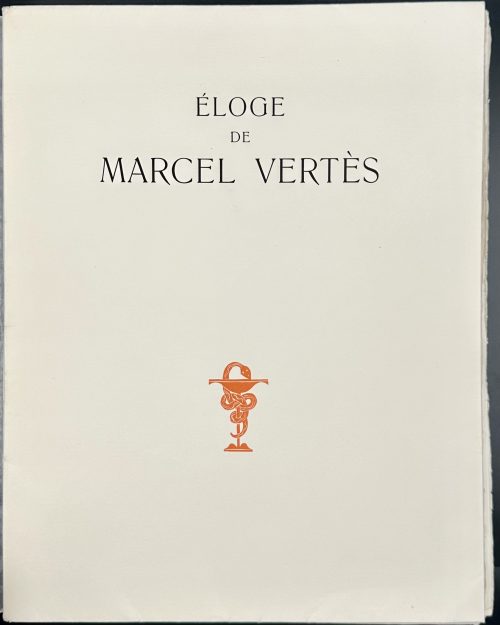 Softcover, 325 x 253 mm, publisher’s French flapped wrappers in glassine dust cover, 15 leaves folio folded in half, making 30 in-2o leaves 321 x 250 mm, with two leaves within the wrappers, [1] t.p., [2] Vertès’ blue ink inscription “À Alexaner Sternberg frère Nicolas qui est un garçon charmant et un bon artiste. Vertès.” and drawing, [3] frontispiece, [4-26] text with six full-page, one head- and one tailpiece in dry point technique, with guard tissues, [27] list of plates, [28] colophon, [29] blank; some page numbers manually scripted in pencil to the bottom right corners by a previous owner. Paper watermarked “BFK Rives”. Title-page (in orange and black): ÉLOGE | DE | MARCEL VERTÈS | PAR | GEORGES HUISMAN | ORNÉ | DE GRAVURES ORIGINALES | {publisher’s device} | MANUEL BRUKER ÉDITEUR || Colophon: CET OUVRAGE A ÉTÉ ACHEVÉ D'IMPRIMER SUR LES PRESSES DE L'IMPRIMERIE DARAGNÈS LE 30 OCTOBRE 1951 A 200 EXEMPLAIRES NUMÉROTÉS DONT 20 SUR VÉLIN 'ARCHES DE 1 A 20 AUXQUELS IL A ÉTÉ JOINT UNE SUITE DES GRAVURES SUR JAPON NACRÉ ET 180 SUR VÉLIN BLANC DE RIVES DE 21 A 200. ON A TIRÉ EN OUTRE 20 SUITES SUR MALACCA DES PLANCHES REFUSÉES. EXEMPLAIRE N° 93. Limitation: 200 copies printed on October 30, 1951, at Daragnès press: 20 (№№ 1-20) on Arches vellum paper with a suite of plates on Japon Nacré and 180 (№№ 21-200) Vélin Blanc by Rives. This is copy № 93. Tipped in: (1) photo of Vertès (and one more) in front of his murals, with the blue ballpoint pen inscription “À Alex Sternberg, frère de Nicola, excellent ami, excellent artiste et voyez, quel photographe!!! Vertès”; (2) postcard with a signed invitation to Vertès' exhibition by Librairie M.-P. Tremois: “Carte Postale | Paris, le 2 mars [19]28 | Monsieur, | Du 6 au 24 mars, | de 2 heures à 6h30, aura | lieu à la Librairie M.-P. Trémois | 43 avenue Rapp, 7e, une | exposition de dessins et | aquarelles de Vertès, ayant | servi à l’illustration de livres. | Nous espérons que vous | voudrez bien nous honorer | de votre visite. M.-P. Trémois.” The drypoint technique is confirmed by the presence of a white line in the middle of the black printed line on the micro photo:
Softcover, 325 x 253 mm, publisher’s French flapped wrappers in glassine dust cover, 15 leaves folio folded in half, making 30 in-2o leaves 321 x 250 mm, with two leaves within the wrappers, [1] t.p., [2] Vertès’ blue ink inscription “À Alexaner Sternberg frère Nicolas qui est un garçon charmant et un bon artiste. Vertès.” and drawing, [3] frontispiece, [4-26] text with six full-page, one head- and one tailpiece in dry point technique, with guard tissues, [27] list of plates, [28] colophon, [29] blank; some page numbers manually scripted in pencil to the bottom right corners by a previous owner. Paper watermarked “BFK Rives”. Title-page (in orange and black): ÉLOGE | DE | MARCEL VERTÈS | PAR | GEORGES HUISMAN | ORNÉ | DE GRAVURES ORIGINALES | {publisher’s device} | MANUEL BRUKER ÉDITEUR || Colophon: CET OUVRAGE A ÉTÉ ACHEVÉ D'IMPRIMER SUR LES PRESSES DE L'IMPRIMERIE DARAGNÈS LE 30 OCTOBRE 1951 A 200 EXEMPLAIRES NUMÉROTÉS DONT 20 SUR VÉLIN 'ARCHES DE 1 A 20 AUXQUELS IL A ÉTÉ JOINT UNE SUITE DES GRAVURES SUR JAPON NACRÉ ET 180 SUR VÉLIN BLANC DE RIVES DE 21 A 200. ON A TIRÉ EN OUTRE 20 SUITES SUR MALACCA DES PLANCHES REFUSÉES. EXEMPLAIRE N° 93. Limitation: 200 copies printed on October 30, 1951, at Daragnès press: 20 (№№ 1-20) on Arches vellum paper with a suite of plates on Japon Nacré and 180 (№№ 21-200) Vélin Blanc by Rives. This is copy № 93. Tipped in: (1) photo of Vertès (and one more) in front of his murals, with the blue ballpoint pen inscription “À Alex Sternberg, frère de Nicola, excellent ami, excellent artiste et voyez, quel photographe!!! Vertès”; (2) postcard with a signed invitation to Vertès' exhibition by Librairie M.-P. Tremois: “Carte Postale | Paris, le 2 mars [19]28 | Monsieur, | Du 6 au 24 mars, | de 2 heures à 6h30, aura | lieu à la Librairie M.-P. Trémois | 43 avenue Rapp, 7e, une | exposition de dessins et | aquarelles de Vertès, ayant | servi à l’illustration de livres. | Nous espérons que vous | voudrez bien nous honorer | de votre visite. M.-P. Trémois.” The drypoint technique is confirmed by the presence of a white line in the middle of the black printed line on the micro photo: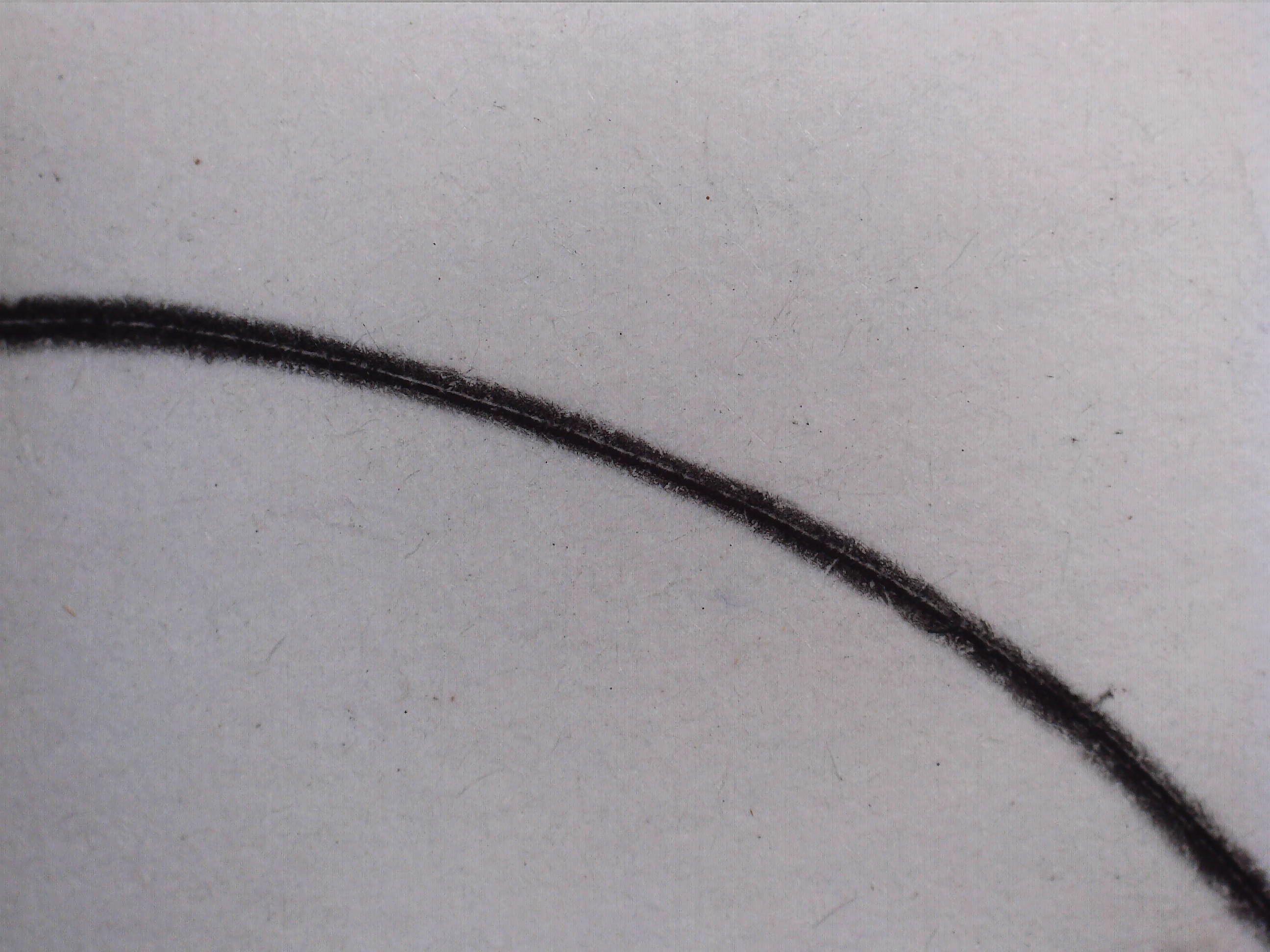 Catalogue raisonné: Vokaer № 52.
Contributors:
Georges Huisman (French, 1889 – 1957) – author.
Marcel Vertès [Marcell Vértes] (Jewish-Hungarian-French, 1895 – 1961) – character/artist.
Manuel Bruker (French, 1891 – 1979) – publisher.
Jean-Gabriel Daragnès (French, 1886 – 1950) – printer.
Nicolas Sternberg (Hungarian-French, 1902 –1960)
Librairie M.-P. Trémois (1925 – 1953)
Catalogue raisonné: Vokaer № 52.
Contributors:
Georges Huisman (French, 1889 – 1957) – author.
Marcel Vertès [Marcell Vértes] (Jewish-Hungarian-French, 1895 – 1961) – character/artist.
Manuel Bruker (French, 1891 – 1979) – publisher.
Jean-Gabriel Daragnès (French, 1886 – 1950) – printer.
Nicolas Sternberg (Hungarian-French, 1902 –1960)
Librairie M.-P. Trémois (1925 – 1953) -
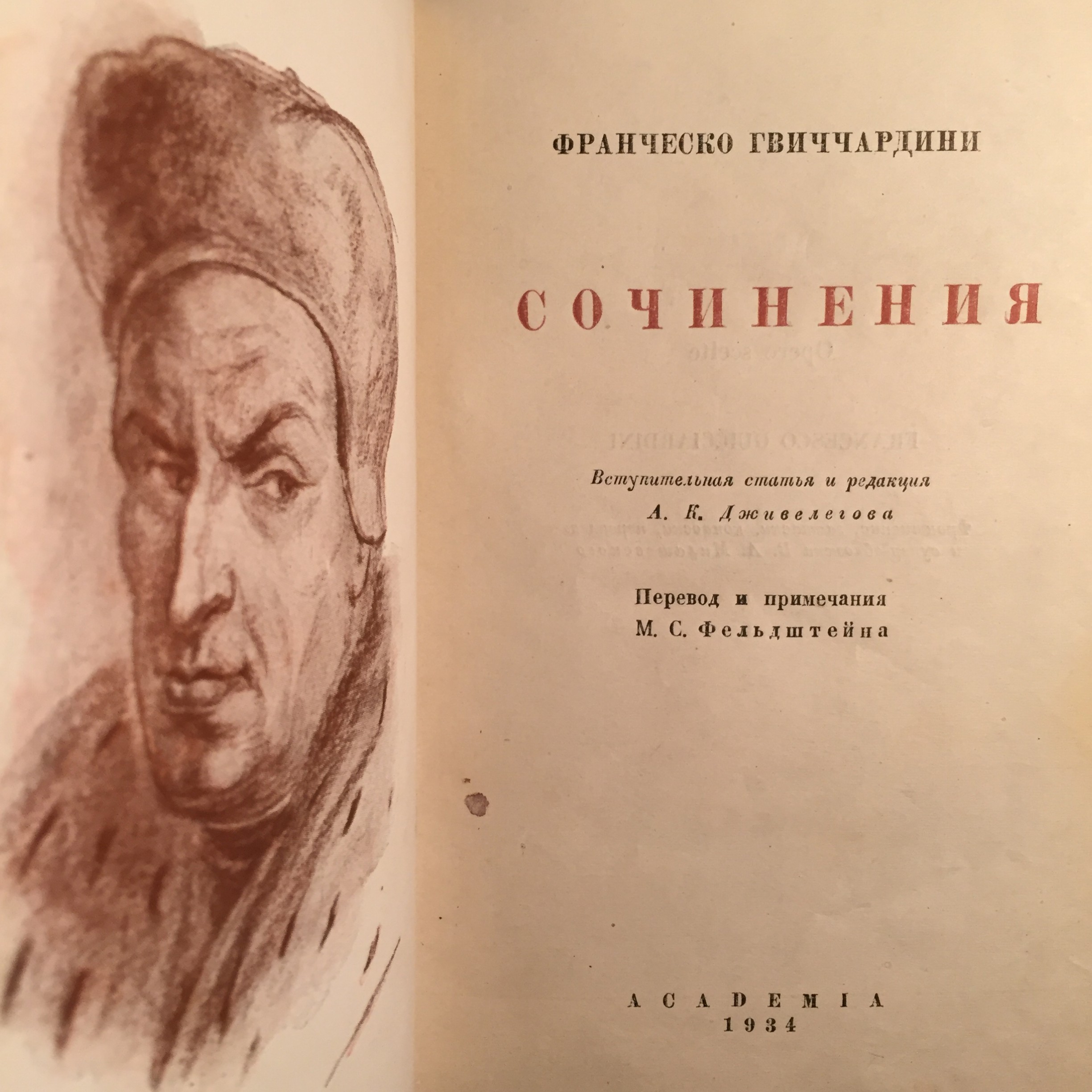
Гвиччардини Франческо. Сочинения. Вступительная статья и редакция Алексея Карповича Дживелегова. Пер.М.Фельдштейна. -- М.: Academia, 1934. -- 552 стр. Тираж: 5300 экз.
Заметки о делах политических и гражданских. Семейная хроника. Воспомнинания о себе самом.
Серия: "Итальянская литература" под общей редакцией А. К. Дживелегова.
-
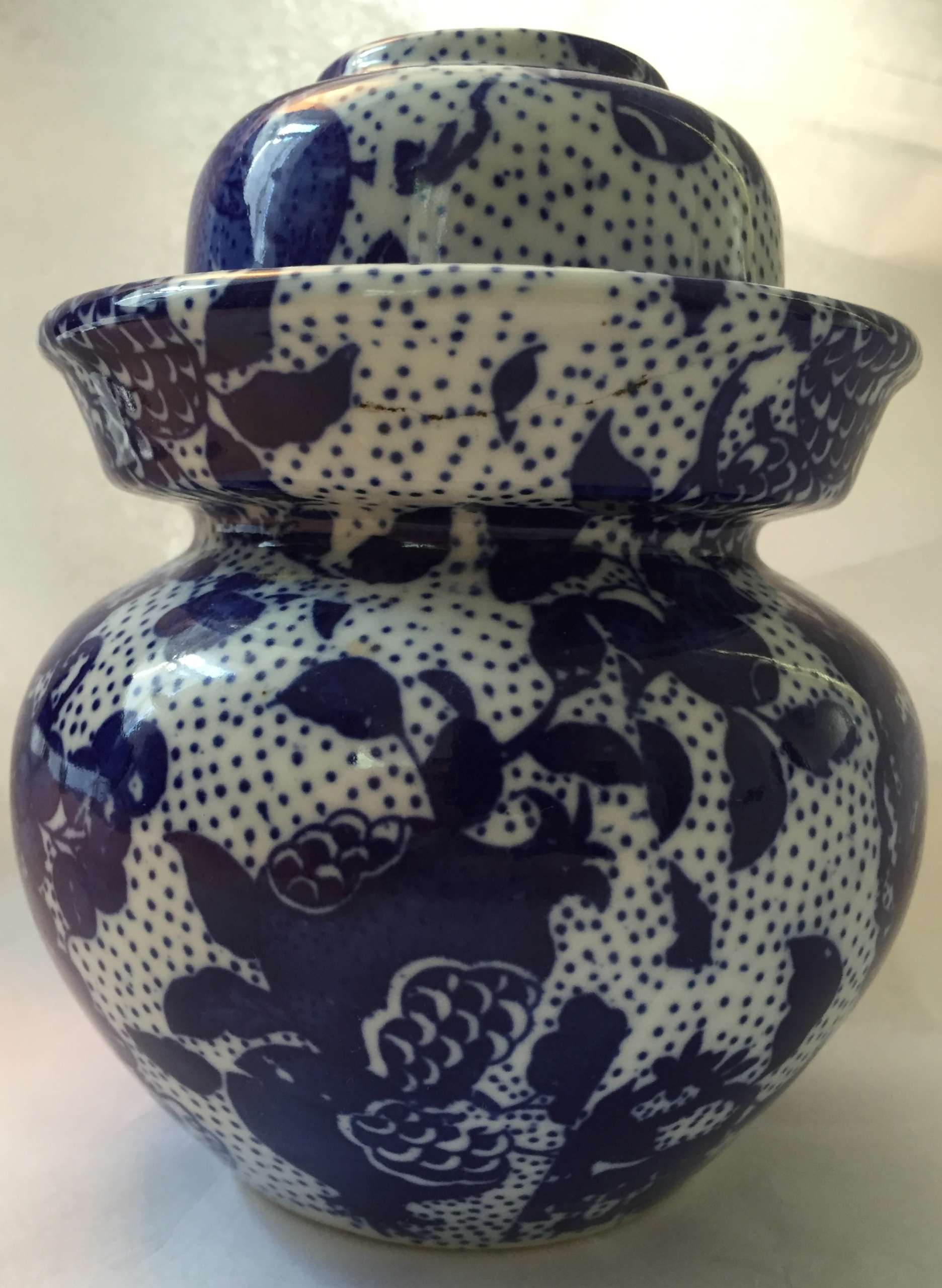 SOLD A Chinese vessel with pomegranates and grapes, of two parts - the vessel and a cup. Blue and white porcelain, decorated under the glaze with a blue pigment by transfer-printing. Imperial reign mark on the bottom in zhuanshu script: Qianlong (1736-1795).
SOLD A Chinese vessel with pomegranates and grapes, of two parts - the vessel and a cup. Blue and white porcelain, decorated under the glaze with a blue pigment by transfer-printing. Imperial reign mark on the bottom in zhuanshu script: Qianlong (1736-1795). -
 Late 19th-century (1850-1870) Japanese export fan. This fan has a double leaf painted with a different design on either side. Ivory encrusted with gemstones (birds and shippomon motif). Painting by ukiyo-e artist and printmaker Katsushika Isai (1821–1880) represents a riverside landscape with figures; birds and flowers on the reverse. Signed: Isai ga (為斎画) - "Painted by Isai".
Late 19th-century (1850-1870) Japanese export fan. This fan has a double leaf painted with a different design on either side. Ivory encrusted with gemstones (birds and shippomon motif). Painting by ukiyo-e artist and printmaker Katsushika Isai (1821–1880) represents a riverside landscape with figures; birds and flowers on the reverse. Signed: Isai ga (為斎画) - "Painted by Isai". -
 Iron tsuba of round form with design of wheel (kuruma) in openwork (sukashi). Squared rim. Copper sekigane. Yagyu school. Signed of the face: Fukui Tsuguzaemon. Early Edo period: Late 17th century (Kanbun/Enppo era). Height: 76.7 mm. Width: 76.8 mm. Rim thickness: 5.2 mm. Center thickness: 5.6 mm. Provenance: Sasano Masayuki Collection, № 203: "This design of spoke wheel relates to the 'circular principle' found in the Yagyu philosophy. Although it is very faint, Fukui Tsuguzaemon's signature is visible. Without a signature and based on appearance alone, it would undoubtable attributed to a later period".
Iron tsuba of round form with design of wheel (kuruma) in openwork (sukashi). Squared rim. Copper sekigane. Yagyu school. Signed of the face: Fukui Tsuguzaemon. Early Edo period: Late 17th century (Kanbun/Enppo era). Height: 76.7 mm. Width: 76.8 mm. Rim thickness: 5.2 mm. Center thickness: 5.6 mm. Provenance: Sasano Masayuki Collection, № 203: "This design of spoke wheel relates to the 'circular principle' found in the Yagyu philosophy. Although it is very faint, Fukui Tsuguzaemon's signature is visible. Without a signature and based on appearance alone, it would undoubtable attributed to a later period".Merrily Baird in her book "Symbols of Japan" [Merrily Baird. Symbols of Japan. Thematic motifs in art and design. Rizzoli international publications, Inc., 2001] provides the following explanation of the Wheel-of-the-Law symbol: "The Wheel-of-the-Law or Golden Wheel (rimbo, kinrin) has its origins in India, where it is known as chakra. [...] In Buddhist practice, it has been represented with eight spokes, reflecting the eight-fold path to overcoming worldly desire, and it signifies that all illusions will be crushed by the faith's enlightenment. [...] The Wheel-of-the-Law is an attribute of such deities as Senju Kannon, the Thousand-Armed Kannon, and Dainichi Nyorai, the all-illuminating solar figure who is the principal deity for Shingon Buddhism. From the Edo period on, the wheel also has been used in a secular manner", e.g. on family crests.
-
 Iron tsuba of 8-lobed form pierced with six openings (sukashi) and decorated with design of bamboo and arabesque in flat brass inlay (hira-zōgan). Two of the openings serve as hitsu-ana. The design on the face represents bamboo trunks and leaves, clouds, waves, and vines; on the back - vines and leaves, that forms an arabesque (karakusa) motif. Rounded square rim. 'Silver' patina. Hitsu-ana with copper sekigane. Heianjō (most probable) or Kaga-Yoshirō school. Late Muromachi or Momoyama period; 16th century. Size: Height: 74.6 mm; Width: 69.5 mm; Thickness at seppa-dai: 4.2 mm. Weight: 113.9 g. Provenance: Gary D. Murtha. This tsuba is illustrated at: Japanese sword guards. Onin - Heianjo - Yoshiro by Gary D. Murtha [GDM Publications, 2016, p. 48]: "Iron, 80x75x3 mm tsuba with brass karakusa vines and leaves on one side with bamboo, leaves, and clouds on the reverse. This tsuba is one of those pieces that might be classified as Onin or Heianjo work, but the flush inlay tips it to the Heianjo side. Late Muromachi period." I would like to add that it easily may also be classified as Kaga-Yoshirō. Robert Haynes in Study Collection.., page 32, illustrates a look-a-like example, and writes: "This style of inlay, where the designs on the face and the back are very different, was common to the work of artists in Kyoto in the Momoyama period."
Iron tsuba of 8-lobed form pierced with six openings (sukashi) and decorated with design of bamboo and arabesque in flat brass inlay (hira-zōgan). Two of the openings serve as hitsu-ana. The design on the face represents bamboo trunks and leaves, clouds, waves, and vines; on the back - vines and leaves, that forms an arabesque (karakusa) motif. Rounded square rim. 'Silver' patina. Hitsu-ana with copper sekigane. Heianjō (most probable) or Kaga-Yoshirō school. Late Muromachi or Momoyama period; 16th century. Size: Height: 74.6 mm; Width: 69.5 mm; Thickness at seppa-dai: 4.2 mm. Weight: 113.9 g. Provenance: Gary D. Murtha. This tsuba is illustrated at: Japanese sword guards. Onin - Heianjo - Yoshiro by Gary D. Murtha [GDM Publications, 2016, p. 48]: "Iron, 80x75x3 mm tsuba with brass karakusa vines and leaves on one side with bamboo, leaves, and clouds on the reverse. This tsuba is one of those pieces that might be classified as Onin or Heianjo work, but the flush inlay tips it to the Heianjo side. Late Muromachi period." I would like to add that it easily may also be classified as Kaga-Yoshirō. Robert Haynes in Study Collection.., page 32, illustrates a look-a-like example, and writes: "This style of inlay, where the designs on the face and the back are very different, was common to the work of artists in Kyoto in the Momoyama period." -
 Artist: Kitagawa Utamaro [喜多川 歌麿] (Japanese, c. 1753 – 1806) "This uncommon half-size horizontal ōban ... is most likely one design from a set of twelve prints issued late in Utamaro's life" [Japanese Erotic Fantasies, Hotei Publishing, 2005, p. 143, pl. 47]. Half-size horizontal ōban must be 12.7 x 38 cm. Richard Waldman and Chris Uhlenbeck say it's tanzaku size (13 x 43 cm). In reality, the prints of this series measure 17 x 38 cm, which corresponds exactly to horizontal o-hosoban paper size. I managed to assemble 11 of allegedly 12 designs. 7 of them have genitals colored by hand. It's hard to tell whether it was done by the publisher on demand of a peculiar buyer, or by the owner of the prints who considered the black and white privy parts unnatural. My sequencing of the prints is arbitrary. Transcription of the text may help find the correct order.
Artist: Kitagawa Utamaro [喜多川 歌麿] (Japanese, c. 1753 – 1806) "This uncommon half-size horizontal ōban ... is most likely one design from a set of twelve prints issued late in Utamaro's life" [Japanese Erotic Fantasies, Hotei Publishing, 2005, p. 143, pl. 47]. Half-size horizontal ōban must be 12.7 x 38 cm. Richard Waldman and Chris Uhlenbeck say it's tanzaku size (13 x 43 cm). In reality, the prints of this series measure 17 x 38 cm, which corresponds exactly to horizontal o-hosoban paper size. I managed to assemble 11 of allegedly 12 designs. 7 of them have genitals colored by hand. It's hard to tell whether it was done by the publisher on demand of a peculiar buyer, or by the owner of the prints who considered the black and white privy parts unnatural. My sequencing of the prints is arbitrary. Transcription of the text may help find the correct order. As Japanese Erotic Fantasies put it: "a couple engaged in love-making, their stare fixed outside the picture plane". This is the only image of series that has a reference in available western literature, and the only one found in museum collections: Rijksmuseum Amsterdam (RP-P-1999-2001-16); reference: Fukuda (ed.) (1990), pls. 11-2.
As Japanese Erotic Fantasies put it: "a couple engaged in love-making, their stare fixed outside the picture plane". This is the only image of series that has a reference in available western literature, and the only one found in museum collections: Rijksmuseum Amsterdam (RP-P-1999-2001-16); reference: Fukuda (ed.) (1990), pls. 11-2.
 The scene of this print looks quite similar to that of the Kiyonaga's Sode no maki:
The scene of this print looks quite similar to that of the Kiyonaga's Sode no maki:
 The woman is "a young lady-in-waiting of Shogun's Court or Daimyō's Mansion, enjoying a rare outing from her tedious chores" [Richard Lane]. She is fully dressed in her outer cloak (shikake), white paper hat (agebōshi or tsunokakushi), and toed socks (tabi). A book or maybe, onkotogami (roll of tissues known as 'paper for honourable act' ) is still in the folds of her kimono. She is holding an open fan, either to cover her and her lover's faces from an unsolicited witness or to bring some fresh air to their joined lips. The pair just started their sexual intercourse.
The woman is "a young lady-in-waiting of Shogun's Court or Daimyō's Mansion, enjoying a rare outing from her tedious chores" [Richard Lane]. She is fully dressed in her outer cloak (shikake), white paper hat (agebōshi or tsunokakushi), and toed socks (tabi). A book or maybe, onkotogami (roll of tissues known as 'paper for honourable act' ) is still in the folds of her kimono. She is holding an open fan, either to cover her and her lover's faces from an unsolicited witness or to bring some fresh air to their joined lips. The pair just started their sexual intercourse.
 A scene from medieval times. A courtier in eboshi cap having sex with an aristocratic young woman with a long straight hairstyle (suihatsu).
A scene from medieval times. A courtier in eboshi cap having sex with an aristocratic young woman with a long straight hairstyle (suihatsu).
 Completely naked couple in the moment of ejaculation. Lavish garments with paulownia leaves on a yellow background counterbalance the white bodies on red bedding. The form of a woman's cheeks is telling, but I don't know about what. Maybe her advanced age?
Completely naked couple in the moment of ejaculation. Lavish garments with paulownia leaves on a yellow background counterbalance the white bodies on red bedding. The form of a woman's cheeks is telling, but I don't know about what. Maybe her advanced age?
 The pose of the couple and the overall composition are similar to that of the previous sheet. Though the lovers are dressed, and the woman's hairdo is well kept. The male looks older and the woman - younger.
The pose of the couple and the overall composition are similar to that of the previous sheet. Though the lovers are dressed, and the woman's hairdo is well kept. The male looks older and the woman - younger.
 A man takes a young maid from behind. She clenches the sleeve of her kimono in her teeth; it's either the moment of penetration (beginning of intercourse) or of her orgasm (the end of it).
A man takes a young maid from behind. She clenches the sleeve of her kimono in her teeth; it's either the moment of penetration (beginning of intercourse) or of her orgasm (the end of it).
 This seems to be a forced intercourse between a lackey with extensive bodily hair and a young maid from the same household.
This seems to be a forced intercourse between a lackey with extensive bodily hair and a young maid from the same household.
 This design is very much like the other one presented below, which is described at Japanese Erotic Fantasies on page 136 (pl. 43b) as follows: "The viewer peers through a mosquito net to see a child fast asleep, while his mother or wet-nurse moves towards her partner. On our print there is no child; instead of a sleeping baby, there is a roll of onkotogami. Fewer objects make the overall image concise, almost laconic in comparison with the Ehon hana fubuki (1802) design:
This design is very much like the other one presented below, which is described at Japanese Erotic Fantasies on page 136 (pl. 43b) as follows: "The viewer peers through a mosquito net to see a child fast asleep, while his mother or wet-nurse moves towards her partner. On our print there is no child; instead of a sleeping baby, there is a roll of onkotogami. Fewer objects make the overall image concise, almost laconic in comparison with the Ehon hana fubuki (1802) design:

 A young couple in a moment of true love. He is listening to the beating of her heart.
A young couple in a moment of true love. He is listening to the beating of her heart.
 This is a moment of true love between an old monk and a young samurai. The latter even did not take of his socks (tabi).
This is a moment of true love between an old monk and a young samurai. The latter even did not take of his socks (tabi).
 From Japanese Erotic Fantasies: "Boats played a crucial role in the workings of Yoshiwara, as they were the primary means of transport to the district. During the hot summer months, trips on pleasure boats were also a favourite pastime. Sex aboard a boat is a recurrent theme in shunga".
The last print that I am currently lacking and hunting for:
From Japanese Erotic Fantasies: "Boats played a crucial role in the workings of Yoshiwara, as they were the primary means of transport to the district. During the hot summer months, trips on pleasure boats were also a favourite pastime. Sex aboard a boat is a recurrent theme in shunga".
The last print that I am currently lacking and hunting for:
 I know where it is, but I cannot reach it... yet.
I know where it is, but I cannot reach it... yet. -

Copper tsuba of oval form carved in kebori and katakiribori with Tekkai Sennin sitting under bamboo on the face and with a pine tree on the back. Ishime-ji treated surface.
Signed on the reverse: Jōi (乗 意).
Edo period (First half of 18th century). Dimensions: 69.6 x 66.5 x 4.5 mm Sugiura Jōi (杉 浦 乗 意) was a master of Nara School in Edo; he was a student of Toshinaga [M. Sesko, 'Genealogies', p. 32]. "Sugiura Jōi (1701-1761) made many fuchigashira and kozuka, tsuba are rather rare." [M. Sesko, The Japanese toso-kinko Schools]. -

Iron tsuba of elongated round form with brown (chocolate) patina. The surface is carved with file strokes (sujikai-yasurime) to imitate heavy rain. The design of a bird drinking water from a bucket hanging on a rope is carved in low relief (sukidashi-bori); the rope is inlaid in gold. The well structure on the reverse, carved in low relief. Nakago-ana is enlarged and plugged with copper sekigane. Unsigned.
Edo period.Size: Height: 75.1 mm; Width: 68.3 mm; Thickness: 4.6 mm; Weight: 134 g.
Unsigned.
SOLD -
 Santō Kyōden (山東 京伝, September 13, 1761 Edo – October 27, 1816) was a Japanese poet, writer and artist in the Edo period. He studied ukiyo-e under master Kitao Shigemasa (北尾 重政) [see SVJP-0006], and began illustrating kibyōshi under the pseudonym of Kitao Masanobu (北尾 政寅).
Santō Kyōden (山東 京伝, September 13, 1761 Edo – October 27, 1816) was a Japanese poet, writer and artist in the Edo period. He studied ukiyo-e under master Kitao Shigemasa (北尾 重政) [see SVJP-0006], and began illustrating kibyōshi under the pseudonym of Kitao Masanobu (北尾 政寅).Signed: Masunobu ga.
"Parody of the Nō Play Chōryō" (elsewhere) or "Parody of Huáng Shigōng and Zhāng Liáng" (David Waterhouse, The Harunobu Decade, Hotei Publishing, 2013, v. 2, №651). "The story [...] is about an encounter between the Chinese government minister Chôryô (Zhāng Liáng) and the legendary elder Kôsekikô (Huáng Shigōng) in the 3rd century BC. While riding a mule across a bridge, Kôsekikô dropped his sandal. Chôryô returned it to him. As a reward, Kôsekikô gave Chôryô a book of military strategy. Later, Chôryô helped to establish the Han Dynasty (207 BC-AD 220)." [The Walters Art Museum]References:
Waterhouse, The Harunobu Decade (2013), #651; Ukiyo-e shûka supp. 2 (1982), pl. 625; Pins, The Japanese Pillar Print (1982), #274/p.145; J. Kurth, Die Geschichte..., vol. II, Leipzig, 1928; S. Kikuchi, Ukiyo-e, 1966.
-
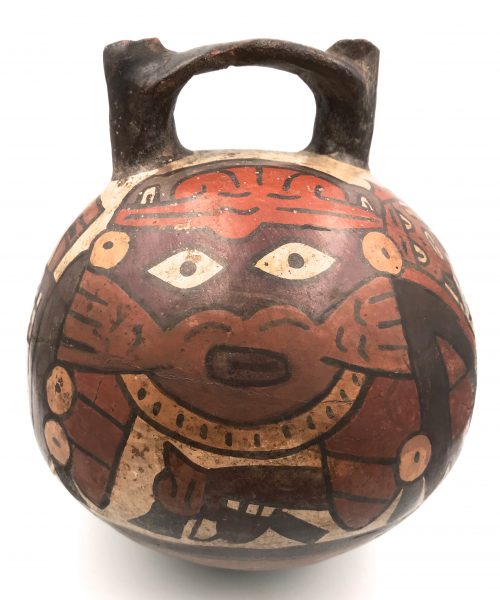
Pre-Columbian, South Coast of Peru, Nazca, ca.200 - 500 CE. Polychrome double-spout, or stir-up vessel (jar, or bottle), decorated on both sides with designs of anthropomorphic Mythical Spotted Cat (or the Cat Deity) with hand holding the club, a trophy head and spears.
Colors: Black, Cream, Gray, Orange, White, Dark Red (7 colors).
Size: Diameter 15.2 cm. References:- A Sourcebook of Nasca Ceramic Iconography: Reading a Culture through Its Art. Donald A. Proulx. University of Iowa Press, 2006; pp. 88-91. [LIB-1556].
- The Archaeology and Pottery of Nazca, Peru: Alfred Kroeber’s 1926 Expedition. Alfred L. Kroeber and Donald Collier, edited by Patrick H. Carmichael with an afterword by Katharina J. Schreiber. AltaMira Press in coop. with Field Museum, Chicago, Il., 1998; p.121. [LIB-1557].
-

Iron tsuba of diamond form with rounded corners with the design of a double gourd on a branch in openwork. Dark brown patina. Ko-Shōami school. Custom kiri-wood box with hakogaki of Sasano Masayuki.
Momoyama Period (1574-1603)
Size: 77.1 x 75.7 x 4.6 mm; weight: 75.3 g.
Provenance: Sasano Masayuki[Translated by Markus Sesko]Hakogaki lid outside: 古正阿弥鐔 Ko-Shōami tsuba Hakogaki lid inside:Hyōtan-sukashi Mumei, Momoyama-ki saku Tetsu, ji-sukashi Koboku-aware no kasaku Heisei ninen Soshinkan Minazuki Openwork design of gourd Unsigned, Momoyama era work Iron, large openwork Masterwork full of classical charm. June of 1990, Soshinkan [pen name of Sasano Masayuki]瓢簞透 無銘 桃山期作 鉄地透
古撲惻之佳作 平成二年 素心鑑 水無月
-
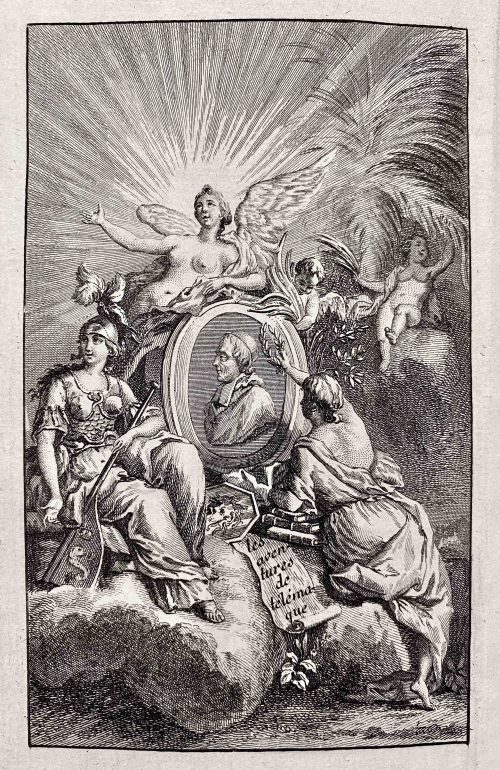 Les Aventures de Télémaque, fils d'Ulysse, Par feu Messire François de Salignac de la Mothe-Fénelon, Précepteur de Messeigneurs les Enfants de France, & depuis Archevêque - Duc de Chabray, Prince du Saint-Empire Romain, &c. / Nouvelle édition enrichie de figures en taille-douce. – À Maestricht, Chez J. E. Dufour & Ph. Roux, Imprimeurs-Libraires associés. M. DCC. LXXXII. Pagination: ffl, [i, ii - ht, explication] [2 - blank, frontis. portrait] [iii, iv - t.p., blank] [v - discours] vi-xxviii, [1] 2-484, bfl; 1 folding map and 24 plates engraved by Jean-Baptiste-Pierre Tardieu. Size: 8vo, 21 x 13 cm. Binding: full contemporary mottled calf, marbled end-papers, all margins red, raised bands, floral gilt elements in compartments, red title label, head- and tail-band absent. Point of issue: the vignette in Liv. 1 is upsidedown. Liv. 1 & 8 plates signed: Gravé par Tardieu résident à Malines. Jean Baptiste Pierre Tardieu (French, 1746 – 1816) - engraver and cartographer from a large family of artists and engravers. For English translation of this book see № LIB-2683-2021 in this collection.
Les Aventures de Télémaque, fils d'Ulysse, Par feu Messire François de Salignac de la Mothe-Fénelon, Précepteur de Messeigneurs les Enfants de France, & depuis Archevêque - Duc de Chabray, Prince du Saint-Empire Romain, &c. / Nouvelle édition enrichie de figures en taille-douce. – À Maestricht, Chez J. E. Dufour & Ph. Roux, Imprimeurs-Libraires associés. M. DCC. LXXXII. Pagination: ffl, [i, ii - ht, explication] [2 - blank, frontis. portrait] [iii, iv - t.p., blank] [v - discours] vi-xxviii, [1] 2-484, bfl; 1 folding map and 24 plates engraved by Jean-Baptiste-Pierre Tardieu. Size: 8vo, 21 x 13 cm. Binding: full contemporary mottled calf, marbled end-papers, all margins red, raised bands, floral gilt elements in compartments, red title label, head- and tail-band absent. Point of issue: the vignette in Liv. 1 is upsidedown. Liv. 1 & 8 plates signed: Gravé par Tardieu résident à Malines. Jean Baptiste Pierre Tardieu (French, 1746 – 1816) - engraver and cartographer from a large family of artists and engravers. For English translation of this book see № LIB-2683-2021 in this collection. -
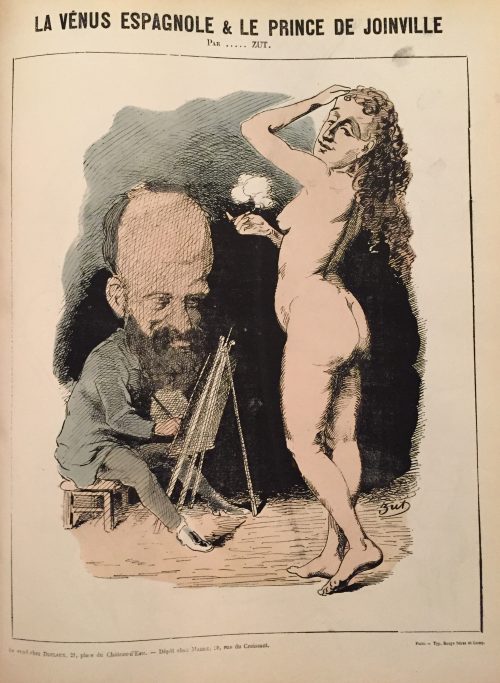 La vénus espagnole et le prince de Joinville par Zut [The Spanish Venus and the Prince of Joinville, by Zut]. Empress Eugénie poses naked for the Prince de Joinville holding a cigarette in her hand. He stares at her intently from his easel.
La vénus espagnole et le prince de Joinville par Zut [The Spanish Venus and the Prince of Joinville, by Zut]. Empress Eugénie poses naked for the Prince de Joinville holding a cigarette in her hand. He stares at her intently from his easel. -
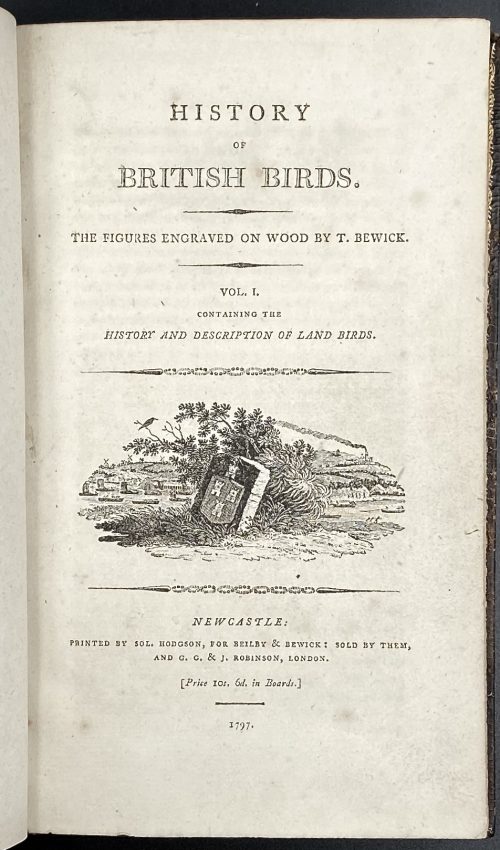 Volume 1: Title: HISTORY | OF | BRITISH BIRDS. | THE FIGURES ENGRAVED ON WOOD BY T. BEWICK. | VOL. I. | CONTAINING THE | HISTORY AND DESCRIPTION OF LAND BIRDS. | [Vignette] | NEWCASTLE: | PRINTED BY SOL. HODGSON, FOR BEILBY & BEWICK : SOLD BY THEM, | AND G. G. & J. ROBINSON, LONDON. | [Price 10s 6d. in Boards] | 1797|| Pagination: [2 blanks], [i, ii] – t.p. / blank, [iii] iv-xxx, [2] – f.t. / blank, [1] 2-335 [336 advert.] [2 blanks]; vignettes on t.p.'s; head- and tail-pieces; publisher's advertisement on final p. of v. 1. Collation: demi 8vo; a-b8, B-Y8; no sigs. A, p. 279 numbered correctly. Woodcuts: 140 descriptions of birds, 117 figures of birds, 91 vignettes, tail-pieces, etc. 1,000 copies printed. Variant B with a vignette at p. 22 printed vertically. Vignette at p. 285 without bars. Volume 2: Title: HISTORY | OF | BRITISH BIRDS. | THE FIGURES ENGRAVED ON WOOD BY T. BEWICK. | VOL. I. | CONTAINING THE | HISTORY AND DESCRIPTION OF WATER BIRDS. | [Vignette] | NEWCASTLE: | PRINTED BY EDWARD WALKER, FOR T. BEWICK : SOLD BY HIM, AND | LONGMAN AND REES, LONDON. | [Price 12s in Boards] | 1804|| Pagination: [2 blanks], [i, ii] – t.p. / blank; [iii] iv-xx, [1] 2-400, [2 blanks]. Collation: Demy 8vo in fours; a2 b-c4, A-3D4; E2, P2, Cc2 insigned. Woodcuts: 144 descriptions of birds, 101 figures of birds, 136 vignettes, tail-pieces, etc. Variant C: Vignette on p. 136 in 1st state, vignettes on pp. 269 and 359 in 2nd state. Binding: speckled full brown calf (restored), contemporary boards ruled in gilt, later spine with raised bands, gilt lettering and florets in compartments, marbled endpapers; 261 woodcut illustrations; printed on wove paper. In both volumes: armorial bookplate of "Clark, Knedlington, Yorks." with the motto "The time will come" on the front pastedown. Size: 21.5 x 14 cm, page: 20.6 x 12.6 cm, demi 8vo. Catalogue raisonné: Hugo (1866): № (99) 94 –120 (108) / pp. 40-58; Roscoe (1953): № 14 a-d, 17 a-d / pp. 46-52 and 65-76. See later edition in this collection: LIB-0860.2015.
Volume 1: Title: HISTORY | OF | BRITISH BIRDS. | THE FIGURES ENGRAVED ON WOOD BY T. BEWICK. | VOL. I. | CONTAINING THE | HISTORY AND DESCRIPTION OF LAND BIRDS. | [Vignette] | NEWCASTLE: | PRINTED BY SOL. HODGSON, FOR BEILBY & BEWICK : SOLD BY THEM, | AND G. G. & J. ROBINSON, LONDON. | [Price 10s 6d. in Boards] | 1797|| Pagination: [2 blanks], [i, ii] – t.p. / blank, [iii] iv-xxx, [2] – f.t. / blank, [1] 2-335 [336 advert.] [2 blanks]; vignettes on t.p.'s; head- and tail-pieces; publisher's advertisement on final p. of v. 1. Collation: demi 8vo; a-b8, B-Y8; no sigs. A, p. 279 numbered correctly. Woodcuts: 140 descriptions of birds, 117 figures of birds, 91 vignettes, tail-pieces, etc. 1,000 copies printed. Variant B with a vignette at p. 22 printed vertically. Vignette at p. 285 without bars. Volume 2: Title: HISTORY | OF | BRITISH BIRDS. | THE FIGURES ENGRAVED ON WOOD BY T. BEWICK. | VOL. I. | CONTAINING THE | HISTORY AND DESCRIPTION OF WATER BIRDS. | [Vignette] | NEWCASTLE: | PRINTED BY EDWARD WALKER, FOR T. BEWICK : SOLD BY HIM, AND | LONGMAN AND REES, LONDON. | [Price 12s in Boards] | 1804|| Pagination: [2 blanks], [i, ii] – t.p. / blank; [iii] iv-xx, [1] 2-400, [2 blanks]. Collation: Demy 8vo in fours; a2 b-c4, A-3D4; E2, P2, Cc2 insigned. Woodcuts: 144 descriptions of birds, 101 figures of birds, 136 vignettes, tail-pieces, etc. Variant C: Vignette on p. 136 in 1st state, vignettes on pp. 269 and 359 in 2nd state. Binding: speckled full brown calf (restored), contemporary boards ruled in gilt, later spine with raised bands, gilt lettering and florets in compartments, marbled endpapers; 261 woodcut illustrations; printed on wove paper. In both volumes: armorial bookplate of "Clark, Knedlington, Yorks." with the motto "The time will come" on the front pastedown. Size: 21.5 x 14 cm, page: 20.6 x 12.6 cm, demi 8vo. Catalogue raisonné: Hugo (1866): № (99) 94 –120 (108) / pp. 40-58; Roscoe (1953): № 14 a-d, 17 a-d / pp. 46-52 and 65-76. See later edition in this collection: LIB-0860.2015. -
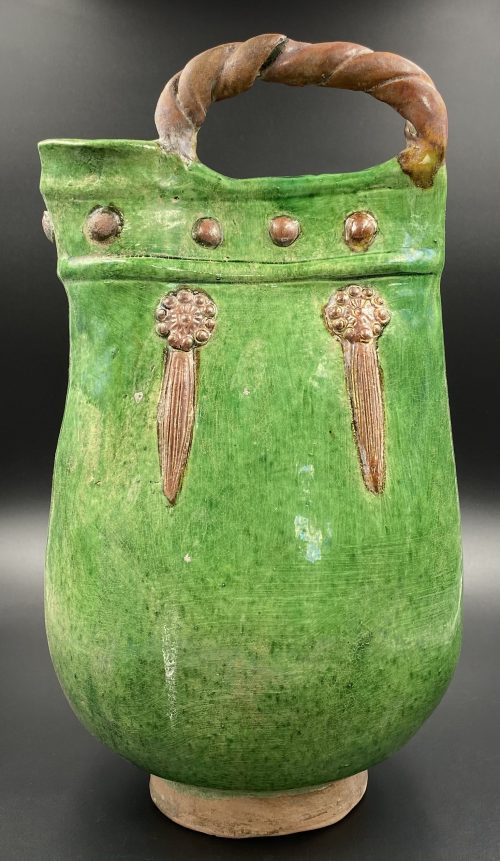 Footed purse-like ewer with twisted handle, with sculptured body glazed in green and details glazed in brown, on an unglazed foot. China, the Liao Dynasty [辽朝] (907 – 1125). Dimensions: 29 x 15 x 15 cm
Footed purse-like ewer with twisted handle, with sculptured body glazed in green and details glazed in brown, on an unglazed foot. China, the Liao Dynasty [辽朝] (907 – 1125). Dimensions: 29 x 15 x 15 cm -
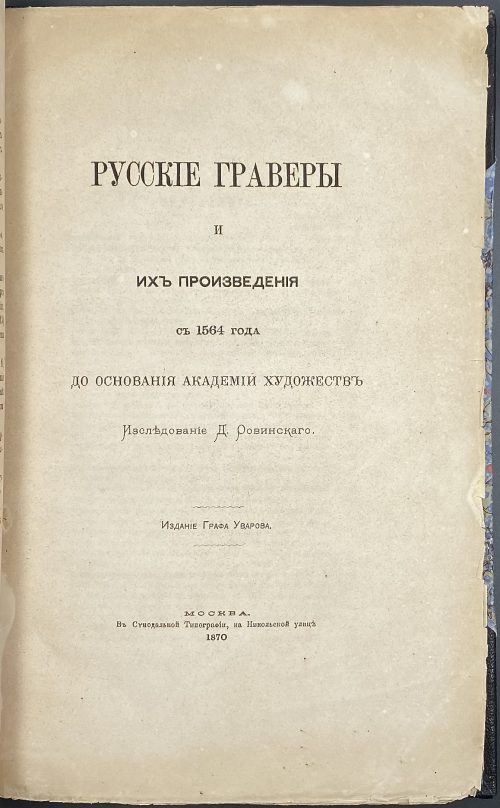 Title: РУССКIЕ ГРАВЕРЫ | И | ИХЪ ПРОИЗВЕДЕНIЯ | СЪ 1564 ГОДА | ДО ОСНОВАНIЯ АКАДЕМIИ ХУДОЖЕСТВЪ. | Изследованiе Д. Ровинскаго. | Изданiе графа Уварова. | МОСКВА. | Въ Сѵнодальной типографiи, на Никольской улицѣ. | 1870. || Pagination: [2] orig. wrapper / advert., [2] t.p. / imp.[i] ii-x, [1] 2-403 [404], [2] orig. wrapper / advert. Collation: 8vo; π6 (incl. t.p.), 1-258 χ2 Binding: Owner’s ½ black morocco over marbled boards, raised bands, gilt-ruled, florets and lettering in compartments, blue endpapers, uncut, untrimmed, original wrappers preserved. Size: 29.5 x 19 cm
Title: РУССКIЕ ГРАВЕРЫ | И | ИХЪ ПРОИЗВЕДЕНIЯ | СЪ 1564 ГОДА | ДО ОСНОВАНIЯ АКАДЕМIИ ХУДОЖЕСТВЪ. | Изследованiе Д. Ровинскаго. | Изданiе графа Уварова. | МОСКВА. | Въ Сѵнодальной типографiи, на Никольской улицѣ. | 1870. || Pagination: [2] orig. wrapper / advert., [2] t.p. / imp.[i] ii-x, [1] 2-403 [404], [2] orig. wrapper / advert. Collation: 8vo; π6 (incl. t.p.), 1-258 χ2 Binding: Owner’s ½ black morocco over marbled boards, raised bands, gilt-ruled, florets and lettering in compartments, blue endpapers, uncut, untrimmed, original wrappers preserved. Size: 29.5 x 19 cm -
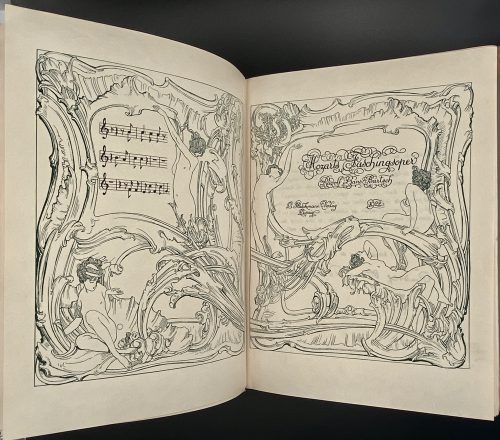 Of the limited edition of 1150 copies, this is №54 (on Japan paper, signed by Bartsch and by von Bayros). Owner's binding imitating quarter-morocco, a red label with gilt lettering to spine (possibly by Ms Hunt, who was an amateur bookbinder). Bookplate on front pastedown: "Ex libris Rachel McMasters Miller Hunt | S. B. Hill Dec 1913 | A.J. Downey Sc." Alfred James Downey (1882-1944). Rachel McMasters Miller Hunt (1882-1963). Sarah B. Hill had done lettering for Ms Hunt. On back pastedown: Stamp "Hunt Libraries CMU" and sticker "Gotham Book Mart | 128 West 45th street | New York". This is from an edition of Carcassonne:
Of the limited edition of 1150 copies, this is №54 (on Japan paper, signed by Bartsch and by von Bayros). Owner's binding imitating quarter-morocco, a red label with gilt lettering to spine (possibly by Ms Hunt, who was an amateur bookbinder). Bookplate on front pastedown: "Ex libris Rachel McMasters Miller Hunt | S. B. Hill Dec 1913 | A.J. Downey Sc." Alfred James Downey (1882-1944). Rachel McMasters Miller Hunt (1882-1963). Sarah B. Hill had done lettering for Ms Hunt. On back pastedown: Stamp "Hunt Libraries CMU" and sticker "Gotham Book Mart | 128 West 45th street | New York". This is from an edition of Carcassonne:
-
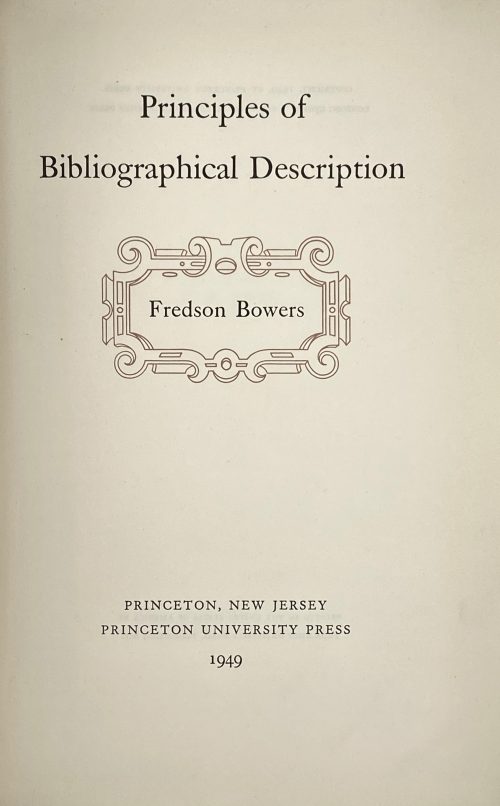 Detailed Bibliographical Description: ( Title: Principles of | Bibliographical Description | Fredson Bowers (in a frame) | PRINCETON, NEW JERSEY | PRINCETON UNIVERSITY PRESS | 1949. Pagination: [i-vii] viii-xvii [xviii] [1-3] 4-505 [506], 2 leaves of plates. Exterior: 24 x 16.5 cm, purple-grey cloth, brown label with gilt lettering to spine, DJ. Fredson Thayer Bowers (American, 1905 – 1991).
Detailed Bibliographical Description: ( Title: Principles of | Bibliographical Description | Fredson Bowers (in a frame) | PRINCETON, NEW JERSEY | PRINCETON UNIVERSITY PRESS | 1949. Pagination: [i-vii] viii-xvii [xviii] [1-3] 4-505 [506], 2 leaves of plates. Exterior: 24 x 16.5 cm, purple-grey cloth, brown label with gilt lettering to spine, DJ. Fredson Thayer Bowers (American, 1905 – 1991). -
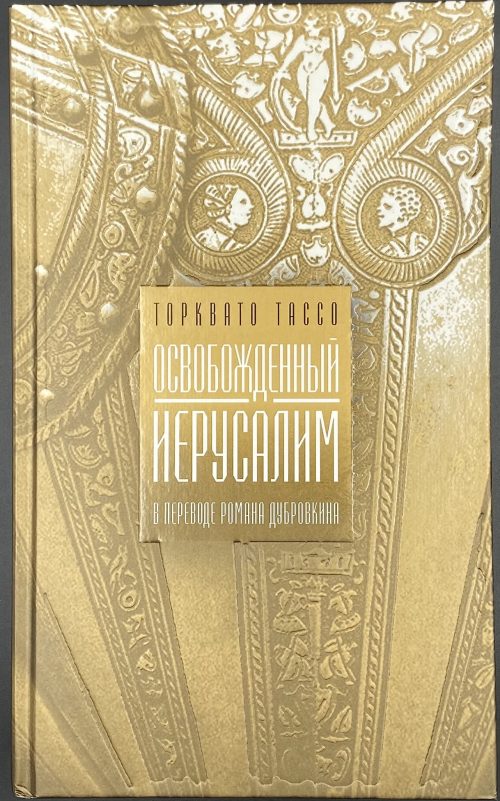 Title page: ТОРКВАТО ТАССО | ОСВОБОЖДЕННЫЙ | ИЕРУСАЛИМ | ПЕРЕВОД С ИТАЛЬЯНСКОГО | РОМАНА ДУБРОВКИНА | {publisher’s device} | САНКТ-ПЕТЕРБУРГ | ИЗДАТЕЛЬСТВО ИВАНА ЛИМБАХА | 2020 || Frontispiece recto: Torquato Tasso portrait by Aegidius Sadeler; verso: TARQUATO TASSO | GERUSALEMME | LIBERATA || Pagination: [1-4] 5-607 [608], il. in text by Charles-Nicolas Cochin, the Younger (French, 1715 – 1790). Hardcover, pictorial paper board, lettering to spine, 25 x 15.5 cm. Print run: 1,000 copies. Original: Torquato Tasso. La Gerusalemme liberata (it.) Translation from the Italian and a foreword by Roman Doubrovkine [Роман Дубровкин] (Russian-Swiss, b. Published in 2020 by Издательство Ивана Лимбаха in St. Petersburg. In this collection: LIB-2639.2021 with illustrations by Hubert François Gravelot (French, 1699–1773); LIB-2636.2021 with illustrations by Bernardo Castello (Italian, 1557–1629), and another translation into Russian by В. С. ЛИХАЧЕВ LIB-2654.2021.
Title page: ТОРКВАТО ТАССО | ОСВОБОЖДЕННЫЙ | ИЕРУСАЛИМ | ПЕРЕВОД С ИТАЛЬЯНСКОГО | РОМАНА ДУБРОВКИНА | {publisher’s device} | САНКТ-ПЕТЕРБУРГ | ИЗДАТЕЛЬСТВО ИВАНА ЛИМБАХА | 2020 || Frontispiece recto: Torquato Tasso portrait by Aegidius Sadeler; verso: TARQUATO TASSO | GERUSALEMME | LIBERATA || Pagination: [1-4] 5-607 [608], il. in text by Charles-Nicolas Cochin, the Younger (French, 1715 – 1790). Hardcover, pictorial paper board, lettering to spine, 25 x 15.5 cm. Print run: 1,000 copies. Original: Torquato Tasso. La Gerusalemme liberata (it.) Translation from the Italian and a foreword by Roman Doubrovkine [Роман Дубровкин] (Russian-Swiss, b. Published in 2020 by Издательство Ивана Лимбаха in St. Petersburg. In this collection: LIB-2639.2021 with illustrations by Hubert François Gravelot (French, 1699–1773); LIB-2636.2021 with illustrations by Bernardo Castello (Italian, 1557–1629), and another translation into Russian by В. С. ЛИХАЧЕВ LIB-2654.2021. -
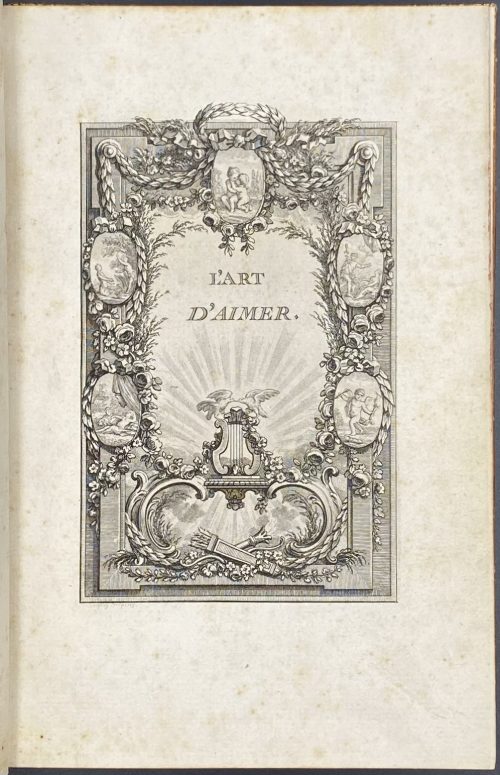 Title: L'ART | D'AIMER, | ET | POÉSIES DIVERSES | DE M. BERNARD. Pagination: [2] – t.p. / stanza by Voltaire; engraved t. p., frontispiece, [1] 2-170; pp. 1-61 – L'art d'aimer; pp. 62-111 – Phrosine et Mélidore; pp. 112-170 – Poésies diverses; illustrations. Collation: 8vo; π1 (letterpress t.p.), A-K8 L5; + 8 plates: (1)* engraved title page facing the stanza by Ch. Baquoy; (2) plate as a frontispiece by Ponce after Ch. Eisen, inscribed Chant I above the image, dated 1772, facing p. [1], chant 1er of l’art; (3)* Ch. Baquoy after P. Martini, inscribed Chant II below the image, facing p. 22, chant 2nd of l’art; (4) Ch. Baquoy after Eisen, inscribed Chant III above the image, facing p. 44, chant 3rd of l’art; (5)* Patas after P. Martini, inscribed Chant Ier below the image, dated 1775, facing p. 62, chant 1er of Phrosine; (6) Ch. Baquoy after Eisen, inscribed Chant II above the image, facing p. 74, chant 2nd of Phrosine; (7)* C. Gaucher after P. Martini, facing p. 84, chant 3rd of Phrosine; (8) Ch. Baquoy after Eisen, inscribed Chant IV above the image, facing p. 97, chant 4th of Phrosine; * – images additional to 1772 edition by Le Jay [LIB-2706.2021] (i.e. plates 1, 3, 5, and 7 are new). A counterfeit edition by an anonymous publisher. Binding: brown pebbled morocco, triple fillet gilt-ruled boards, raised bands, gilt in compartments, gilt label lettering to spine, marbled endpapers, AMG; printed on laid paper, with tall 's'. Catalogue raisonné: Cohen, De Richi (1912): p. 132: describes a counterfeit edition with 170 pages and 3 additional plates plus an engraved title. This seems to be a combination of Lejan [sic] Paris 1775 edition, which normally has 134 pages, 8vo, title engraved by Baquoy and three plates after Martini by Patas, Baquoy and Gaucher. Contributors: Nicolas Ponce (French, 1746 – 1831) – engraver. Jean Charles Baquoy (French, 1721 – 1777) – engraver. Jean-Baptiste Patas (French, 1748 – 1817) – engraver. Charles-Étienne Gaucher (French, 1740 – 1804) – engraver. Charles-Dominique-Joseph Eisen (French, 1720 – 1778) – artist. Pietro Antonio Martini (Italian, 1738 – 1797) – artist. Pierre-Joseph Bernard [Gentil-Bernard] (French, 1708 – 1775) – author of the text.
Title: L'ART | D'AIMER, | ET | POÉSIES DIVERSES | DE M. BERNARD. Pagination: [2] – t.p. / stanza by Voltaire; engraved t. p., frontispiece, [1] 2-170; pp. 1-61 – L'art d'aimer; pp. 62-111 – Phrosine et Mélidore; pp. 112-170 – Poésies diverses; illustrations. Collation: 8vo; π1 (letterpress t.p.), A-K8 L5; + 8 plates: (1)* engraved title page facing the stanza by Ch. Baquoy; (2) plate as a frontispiece by Ponce after Ch. Eisen, inscribed Chant I above the image, dated 1772, facing p. [1], chant 1er of l’art; (3)* Ch. Baquoy after P. Martini, inscribed Chant II below the image, facing p. 22, chant 2nd of l’art; (4) Ch. Baquoy after Eisen, inscribed Chant III above the image, facing p. 44, chant 3rd of l’art; (5)* Patas after P. Martini, inscribed Chant Ier below the image, dated 1775, facing p. 62, chant 1er of Phrosine; (6) Ch. Baquoy after Eisen, inscribed Chant II above the image, facing p. 74, chant 2nd of Phrosine; (7)* C. Gaucher after P. Martini, facing p. 84, chant 3rd of Phrosine; (8) Ch. Baquoy after Eisen, inscribed Chant IV above the image, facing p. 97, chant 4th of Phrosine; * – images additional to 1772 edition by Le Jay [LIB-2706.2021] (i.e. plates 1, 3, 5, and 7 are new). A counterfeit edition by an anonymous publisher. Binding: brown pebbled morocco, triple fillet gilt-ruled boards, raised bands, gilt in compartments, gilt label lettering to spine, marbled endpapers, AMG; printed on laid paper, with tall 's'. Catalogue raisonné: Cohen, De Richi (1912): p. 132: describes a counterfeit edition with 170 pages and 3 additional plates plus an engraved title. This seems to be a combination of Lejan [sic] Paris 1775 edition, which normally has 134 pages, 8vo, title engraved by Baquoy and three plates after Martini by Patas, Baquoy and Gaucher. Contributors: Nicolas Ponce (French, 1746 – 1831) – engraver. Jean Charles Baquoy (French, 1721 – 1777) – engraver. Jean-Baptiste Patas (French, 1748 – 1817) – engraver. Charles-Étienne Gaucher (French, 1740 – 1804) – engraver. Charles-Dominique-Joseph Eisen (French, 1720 – 1778) – artist. Pietro Antonio Martini (Italian, 1738 – 1797) – artist. Pierre-Joseph Bernard [Gentil-Bernard] (French, 1708 – 1775) – author of the text. -
![Adelbert von Chamisso. Peter Schlemihls wundersame Geschichte. – Leipzig: Im Insel-Verlag, [1916 or 1923 or 1940] (Series: Insel-Bücherei, Nr. 194). – pp.: ff [1 t.p., 2 blank] 3-79 [80] bf., with 4 etchings [instead of woodcuts] by Adolf Schrödter [1838].](https://varshavskycollection.com/wp-content/uploads/2021/02/LIB-2497.2020-a-500x740.jpeg) Title (Gothic typeset): Peter Schlemihls | wundersame Geschichte | Mitgeteilt | von | Adelbert von Chamisso | {publisher’s device} | — | Im Insel-Verlag zu Leipzig || Series: Insel-Bücherei, Nr. 194. Pagination: 8vo; [1, 2] 3-79 [80]; 4 photomechanical reproductions of woodcuts by Adolf Schrödter [1838] within collation. Binding: 18.5 x 12.5 cm, hardcover, original patterned paper over cardboard, title label in yellow and black pasted to cover, label to spine. According to Herbert Kästner Die Insel-Bücherei: Bibliographie, 1912 - 1999: 4 illustrations by Adolf Schrödter, produced for 1838 edition as wood engravings here reproduced by photogravure. There were four print runs of this edition: 1916: 1.-10. Tsd; 1923: 35. Tsd; 1940: 55. Tsd. There is currently no way to tell which one is this. Contributors: Chamisso, Adelbert von (German, 1781–1838) – author. Schrödter, Adolf (German, 1805 – 1875) – artist.
Title (Gothic typeset): Peter Schlemihls | wundersame Geschichte | Mitgeteilt | von | Adelbert von Chamisso | {publisher’s device} | — | Im Insel-Verlag zu Leipzig || Series: Insel-Bücherei, Nr. 194. Pagination: 8vo; [1, 2] 3-79 [80]; 4 photomechanical reproductions of woodcuts by Adolf Schrödter [1838] within collation. Binding: 18.5 x 12.5 cm, hardcover, original patterned paper over cardboard, title label in yellow and black pasted to cover, label to spine. According to Herbert Kästner Die Insel-Bücherei: Bibliographie, 1912 - 1999: 4 illustrations by Adolf Schrödter, produced for 1838 edition as wood engravings here reproduced by photogravure. There were four print runs of this edition: 1916: 1.-10. Tsd; 1923: 35. Tsd; 1940: 55. Tsd. There is currently no way to tell which one is this. Contributors: Chamisso, Adelbert von (German, 1781–1838) – author. Schrödter, Adolf (German, 1805 – 1875) – artist. -
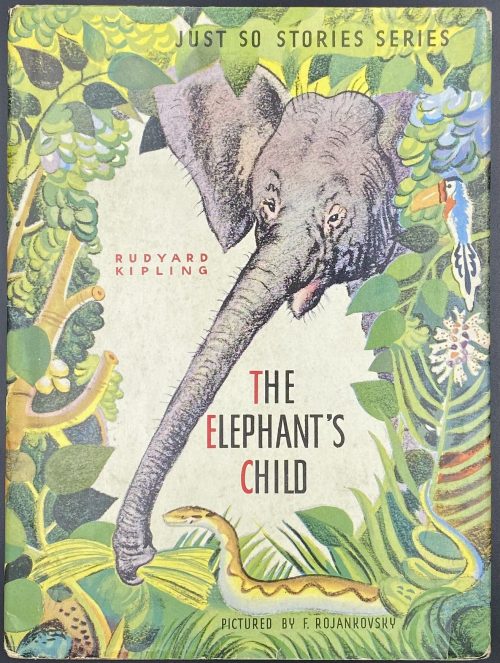 Hardcover volume, 24 x 18 cm, pictorial paper over cardboard boards, pictorial endpapers, and pictorial DJ; pp.: [2] – pictorial t.p. / copyrignt+imprint + [26] unpaginated pages (13 leaves); in-text photomechanical b/w and coloured illustrations after Feodor Rojankovsky. DJ and front cover (pictorial): JUST SO STORIES SERIES | RUDYARD KIPLING | THE | ELEPHANT'S | CHILD | PICTURED BY F. ROJANKOVSKY || Title-page (pictorial): JUST SO STORIES SERIES | THE | ELEPHANT'S | CHILD | RUDYARD KIPLING | ILLUSTRATED BY | F. ROJANKOVSKY | GARDEN CITY PUBLISHING COMPANY, INC., GARDEN CITY, N. Y. || Contributors: Rudyard Kipling (British, 1865 – 1936) Feodor Rojankovsky [Rojan; Фёдор Степанович Рожанковский] (Russian-American, 1891 – 1970)
Hardcover volume, 24 x 18 cm, pictorial paper over cardboard boards, pictorial endpapers, and pictorial DJ; pp.: [2] – pictorial t.p. / copyrignt+imprint + [26] unpaginated pages (13 leaves); in-text photomechanical b/w and coloured illustrations after Feodor Rojankovsky. DJ and front cover (pictorial): JUST SO STORIES SERIES | RUDYARD KIPLING | THE | ELEPHANT'S | CHILD | PICTURED BY F. ROJANKOVSKY || Title-page (pictorial): JUST SO STORIES SERIES | THE | ELEPHANT'S | CHILD | RUDYARD KIPLING | ILLUSTRATED BY | F. ROJANKOVSKY | GARDEN CITY PUBLISHING COMPANY, INC., GARDEN CITY, N. Y. || Contributors: Rudyard Kipling (British, 1865 – 1936) Feodor Rojankovsky [Rojan; Фёдор Степанович Рожанковский] (Russian-American, 1891 – 1970) -
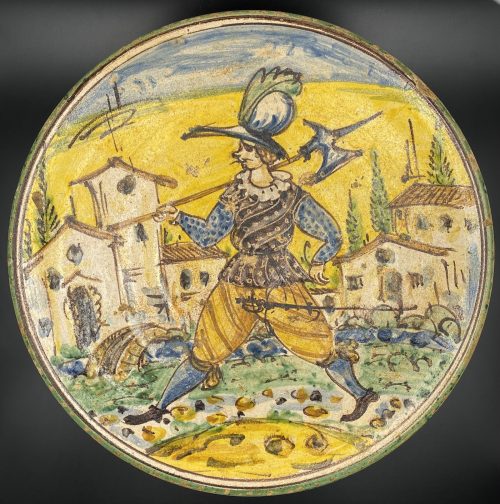 Footed round dish depicting a gentleman in an urban landscape holding a halberd in a style of "Arlecchino di Montelupo". Unsigned. Chips to the bottom. Diameter: 32.5 cm; Height: 4.5 cm. Produced in Italy, in Montelupo, about 20 kilometres (12 miles) southwest of Florence. 17th century, probably the first half. "After 1630, the year of the great plague, the number of potters reduced considerably and in the second half of the 1600s production suffered a drastic slump, potteries that specialized in a more prestigious production disappeared completely leaving only the potteries that produced kitchenware and terracotta objects" [www.tuscany-charming.it].
Footed round dish depicting a gentleman in an urban landscape holding a halberd in a style of "Arlecchino di Montelupo". Unsigned. Chips to the bottom. Diameter: 32.5 cm; Height: 4.5 cm. Produced in Italy, in Montelupo, about 20 kilometres (12 miles) southwest of Florence. 17th century, probably the first half. "After 1630, the year of the great plague, the number of potters reduced considerably and in the second half of the 1600s production suffered a drastic slump, potteries that specialized in a more prestigious production disappeared completely leaving only the potteries that produced kitchenware and terracotta objects" [www.tuscany-charming.it]. -
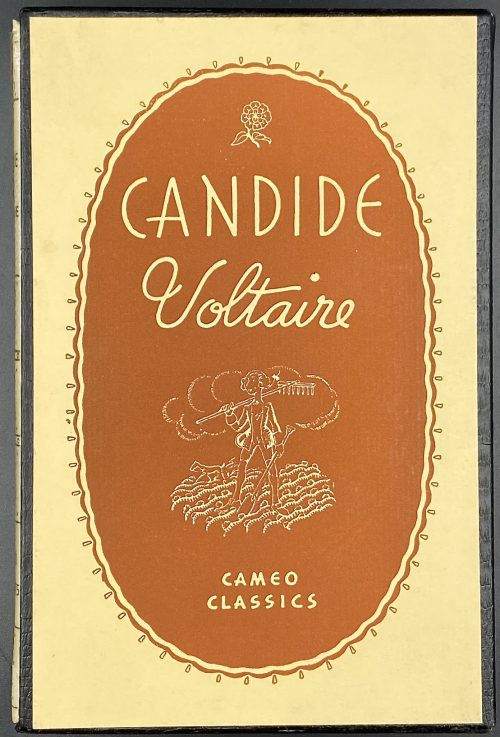 Title (historiated border, three-compartment): CAMEO CLASSICS | {rule} | CANDIDE | BY | Voltaire | WITH ILLUSTRATIONS | BY | Mahlon Blaine | {rule} | GROSSET AND DUNLAP | NEW YORK || Pagination: [1-6] 7-144, total 144 pages; frontispiece plus 4 plates within collation, head- and tailpieces – reproductions of Mahlon Blaine’s pen drawings. Binding: 21 x 14 cm, cream cloth with the cameo of Johann Gutenberg to front cover, gilt lettering to front cover and spine, in acetate dust jacket, in a pictorial slipcase. Arouet, François-Marie [Voltaire] (French, 1694 – 1778)– author. Woolf, Herman Irwell [Chambers, Dorset] (British, 1890 – 1958) – translator. Blaine, Mahlon [Hudson, G. Christopher] (American, 1894 – 1969) – illustrator. Grosset and Dunlap (NY) – publisher. J. J. Little & Ives Company (NY) – printer. Cameo Classics series was published by Grosset & Dunlap (New York) in 1935 – 1948 as a cheap reprint of illustrated classic editions, in this case – of Williams, Belasco and Meyers publication of Candide in 1930 (see LIB-2792.2021). The Cameo Classics books had a clear, acetate dust jacket and were boxed in a buckram alligator skin patterned slipcase with an illustrated cover. The price per volume started at 69 cents and was gradually lowered to 59 and 50 cents per volume by the late 1930s. Candide was translated into English quite a few times, starting from Tobias George Smollett (British-Scottish, 1721 – 1771) and up to today's translators. For some reason, the translator's name is almost never indicated. This translation, published by Williams, Belasco and Meyers in 1930 and reprinted by Grosset and Dunlap in c. 1935, was performed by Herman Irwell Woolf under the pseudonym of Dorset Chambers and first published in London by F.B. Neumayer in 1919. This edition was mentioned in the letter from Joseph Conrad to his son Borys in 1922, May 10.
Title (historiated border, three-compartment): CAMEO CLASSICS | {rule} | CANDIDE | BY | Voltaire | WITH ILLUSTRATIONS | BY | Mahlon Blaine | {rule} | GROSSET AND DUNLAP | NEW YORK || Pagination: [1-6] 7-144, total 144 pages; frontispiece plus 4 plates within collation, head- and tailpieces – reproductions of Mahlon Blaine’s pen drawings. Binding: 21 x 14 cm, cream cloth with the cameo of Johann Gutenberg to front cover, gilt lettering to front cover and spine, in acetate dust jacket, in a pictorial slipcase. Arouet, François-Marie [Voltaire] (French, 1694 – 1778)– author. Woolf, Herman Irwell [Chambers, Dorset] (British, 1890 – 1958) – translator. Blaine, Mahlon [Hudson, G. Christopher] (American, 1894 – 1969) – illustrator. Grosset and Dunlap (NY) – publisher. J. J. Little & Ives Company (NY) – printer. Cameo Classics series was published by Grosset & Dunlap (New York) in 1935 – 1948 as a cheap reprint of illustrated classic editions, in this case – of Williams, Belasco and Meyers publication of Candide in 1930 (see LIB-2792.2021). The Cameo Classics books had a clear, acetate dust jacket and were boxed in a buckram alligator skin patterned slipcase with an illustrated cover. The price per volume started at 69 cents and was gradually lowered to 59 and 50 cents per volume by the late 1930s. Candide was translated into English quite a few times, starting from Tobias George Smollett (British-Scottish, 1721 – 1771) and up to today's translators. For some reason, the translator's name is almost never indicated. This translation, published by Williams, Belasco and Meyers in 1930 and reprinted by Grosset and Dunlap in c. 1935, was performed by Herman Irwell Woolf under the pseudonym of Dorset Chambers and first published in London by F.B. Neumayer in 1919. This edition was mentioned in the letter from Joseph Conrad to his son Borys in 1922, May 10. -
![Owen E. Holloway. French Rococo Book Illustration. – London: Alec Tiranti, 1969. – pp.: ffl [2 blanks] [i-iv] v-vi, 1-283, bfl.](https://varshavskycollection.com/wp-content/uploads/2021/02/LIB-2526.2020-d-500x671.jpeg) Title page (in red and black): FRENCH ROCOCO | BOOK ILLUSTRATION | OWEN E. HOLLOWAY | {vignette} | LONDON/ALEC TIRANTI/1969 || Series: Pagination: [2 blanks], [i-iv] v-vi, 1-115 [116 blank], plus 65 leaves of plates (283 illustrations). Binding: 25.5 x 19 cm; publisher's navy buckram, gilt lettering to spine, pictorial dust jacket, unclipped.
Title page (in red and black): FRENCH ROCOCO | BOOK ILLUSTRATION | OWEN E. HOLLOWAY | {vignette} | LONDON/ALEC TIRANTI/1969 || Series: Pagination: [2 blanks], [i-iv] v-vi, 1-115 [116 blank], plus 65 leaves of plates (283 illustrations). Binding: 25.5 x 19 cm; publisher's navy buckram, gilt lettering to spine, pictorial dust jacket, unclipped. -
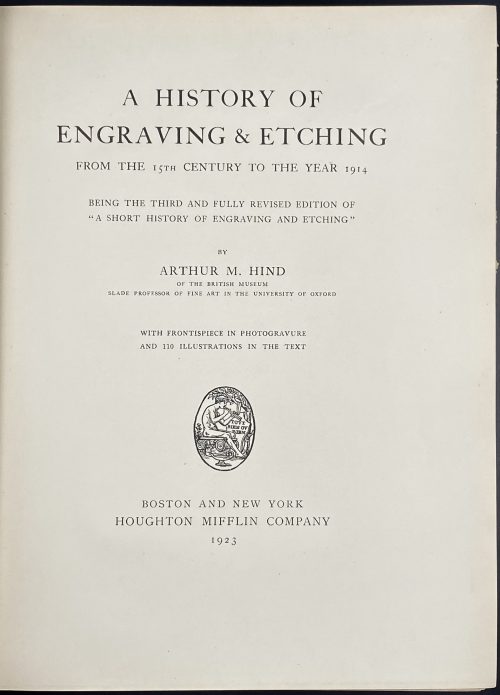 Title: A HISTORY OF | ENGRAVING & ETCHING | FROM THE 15TH CENTURY TO THE YEAR 1914 | BEING THE THIRD AND FULLY REVISED EDITION OF | “A SHORT HISTORY OF ENGRAVING AND ETCHING” | BY | ARTHUR M. HIND | OF THE BRITISH MUSEUM | SLADE PROFESSOR OF FINE ART IN THE UNIVERSITY OF OXFORD | WITH FRONTISPIECE IN PHOTOGRAVURE | AND 110 ILLUSTRATIONS IN THE TEXT | {publisher’s device} | BOSTON AND NEW YORK | HOUGHTON MIFFLIN COMPANY | 1923 || Pagination: [i-iv] v-xiii. [2] – blank / abbrev., [2] 3-487 [488], frontis. w/tissue guard, ills.; Appendices: I. Classified list of engravers (p. 343-392); II. General bibliography (p. 393-419); III. Index of engravers and individual bibliography (p. 420-487). Collation: π10 B-2H8 2I4, frontispiece (extr.), 110 in-text illustrations. Binding: 25.8 x 20 cm, crimson cloth, blind triple-fillet to top and bottom of the front board, same in gilt to spine, gilt lettering to spine, top edge gilt, fore-edge untrimmed. Contributors: Arthur Mayger Hind (British, 1880 – 1957) – author. Houghton Mifflin Company (Boston, 1864) – publisher. R & R. Clark, Ltd. (Edinburgh, 1846) – printer. Note: It is marked as the 3rd edition of A short history of engraving and etching. Indeed, A short history of engraving & etching for the use of collectors and students with full bibliography, classified list and index of engravers was published by Constable in London and Houghton Mifflin Co. in Boston, in 1908 and then in 1911. However, it is hard to consider an almost completely new book "a 3rd edition".
Title: A HISTORY OF | ENGRAVING & ETCHING | FROM THE 15TH CENTURY TO THE YEAR 1914 | BEING THE THIRD AND FULLY REVISED EDITION OF | “A SHORT HISTORY OF ENGRAVING AND ETCHING” | BY | ARTHUR M. HIND | OF THE BRITISH MUSEUM | SLADE PROFESSOR OF FINE ART IN THE UNIVERSITY OF OXFORD | WITH FRONTISPIECE IN PHOTOGRAVURE | AND 110 ILLUSTRATIONS IN THE TEXT | {publisher’s device} | BOSTON AND NEW YORK | HOUGHTON MIFFLIN COMPANY | 1923 || Pagination: [i-iv] v-xiii. [2] – blank / abbrev., [2] 3-487 [488], frontis. w/tissue guard, ills.; Appendices: I. Classified list of engravers (p. 343-392); II. General bibliography (p. 393-419); III. Index of engravers and individual bibliography (p. 420-487). Collation: π10 B-2H8 2I4, frontispiece (extr.), 110 in-text illustrations. Binding: 25.8 x 20 cm, crimson cloth, blind triple-fillet to top and bottom of the front board, same in gilt to spine, gilt lettering to spine, top edge gilt, fore-edge untrimmed. Contributors: Arthur Mayger Hind (British, 1880 – 1957) – author. Houghton Mifflin Company (Boston, 1864) – publisher. R & R. Clark, Ltd. (Edinburgh, 1846) – printer. Note: It is marked as the 3rd edition of A short history of engraving and etching. Indeed, A short history of engraving & etching for the use of collectors and students with full bibliography, classified list and index of engravers was published by Constable in London and Houghton Mifflin Co. in Boston, in 1908 and then in 1911. However, it is hard to consider an almost completely new book "a 3rd edition". -
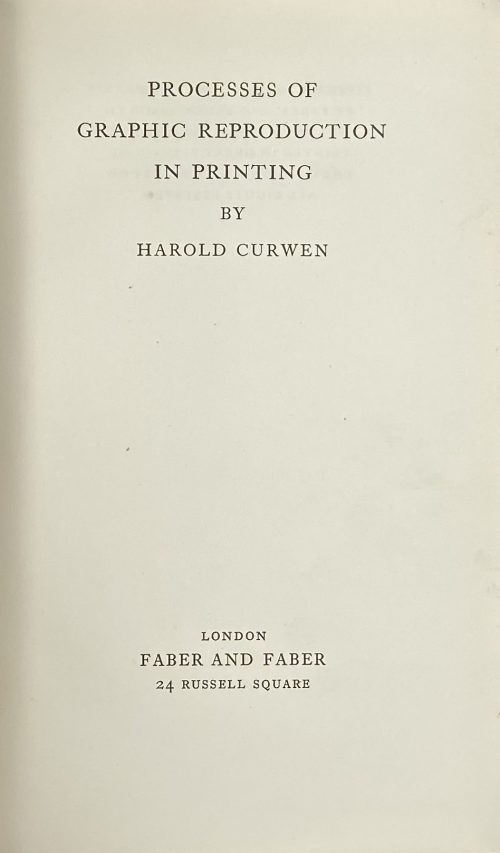 Title: PROCESSES OF | GRAPHIC REPRODUCTION | IN PRINTING | BY | HAROLD CURWEN | [space] | LONDON | FABER AND FABER | 24 RUSSELL SQUARE || Pagination: [i-vii] viii-xvi [6] [1-3] 4-142 [2], ills. Collation: 8vo; π3 [A]8 B-K8, 14 plates extraneous to collation, in-text illustrations; (quire K – 'Binding'). Binding: 22.8 x 15 cm, black cloth, gilt lettering to spine; calligraphic MS bookplate to fep "Dorothy Mahoney | 1942." Edition: 1st edition, printed by The Curwen Press in Plaistow. Contributors: Harold Curwen (British, 1885 – 1949), grandson of John Curwen (British, 1816 – 1880) – author. The Curwen Press (Plaistow, London) – printer. Faber and Faber Limited (London) – publisher. Dorothy Mahoney – provenance; author of the book The Craft Of Calligraphy, first published on October 12th, 1981 by Pelham Books. The 1st American edition was published the same year in New York by Oxford University Press [LIB-2835.2021].
Title: PROCESSES OF | GRAPHIC REPRODUCTION | IN PRINTING | BY | HAROLD CURWEN | [space] | LONDON | FABER AND FABER | 24 RUSSELL SQUARE || Pagination: [i-vii] viii-xvi [6] [1-3] 4-142 [2], ills. Collation: 8vo; π3 [A]8 B-K8, 14 plates extraneous to collation, in-text illustrations; (quire K – 'Binding'). Binding: 22.8 x 15 cm, black cloth, gilt lettering to spine; calligraphic MS bookplate to fep "Dorothy Mahoney | 1942." Edition: 1st edition, printed by The Curwen Press in Plaistow. Contributors: Harold Curwen (British, 1885 – 1949), grandson of John Curwen (British, 1816 – 1880) – author. The Curwen Press (Plaistow, London) – printer. Faber and Faber Limited (London) – publisher. Dorothy Mahoney – provenance; author of the book The Craft Of Calligraphy, first published on October 12th, 1981 by Pelham Books. The 1st American edition was published the same year in New York by Oxford University Press [LIB-2835.2021]. -
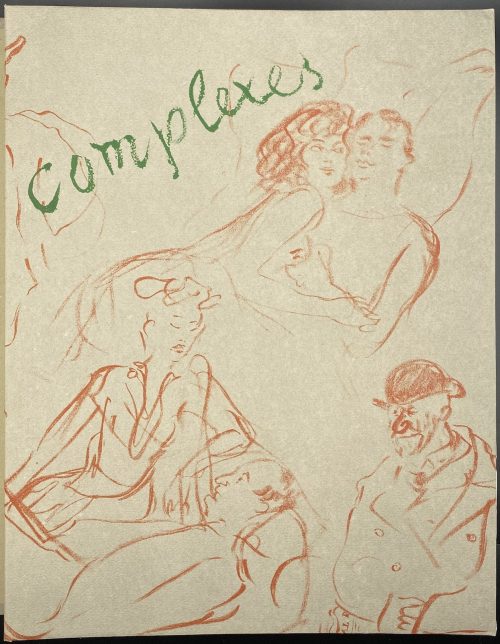 Binding: Grey double-slipcase 34 x 16.5 cm, pictorial folder, French flapped pictorial wrappers, both folder and wrapper with green ms lettering and vignette in sanguine, green ms lettering to spine. Collation: folio in-4to, two leaves in wrappers at the front and back, π8, 104 [11]2, total 50 leaves, incl. plates. Pagination: [4], [2] h.t. / limitation, [2] blank, [1-3] blank, [4-6] frontis., t.p., blank. 7-86 [2] [4] colophon, 100 pages total. Title-page (sanguine and black): COMPLEXES | 40 | DESSINS DE | Vertès | PREFACE DE | PIERRE MAC ORLAN | ANDRÉ SAURET | ÉDITIONS DU LIVRE ★ MONTE-CARLO || Illustrations: One on the front covers, one on the back one headpiece vignette, 37 plates, incl. frontispiece in colour and three on a double-page (full leaf), and one original pencil drawing. Limitation: 890 copies of which 40 (№ 1-40) signed by the artist and contain one original drawing; this copy is № 27. Edition: published by André Sauret, lithographs after Vertès drawings by Georges Duval, printed by Fernand Mourlot; text printed at “La Ruche” under the direction of A. and P. Jarach. Print run completed on November 9, 1948. Contributors: Pierre Mac-Orlan (French, 1882 – 1970) – author. Marcel Vertès [Marcell Vértes] (Jewish-Hungarian-French, 1895 – 1961) – artist. André Sauret (Monaco, fl. 1952 – 1976) – publisher. Other names: Marcel Vertès, Marcel Vertes, Marcell Vértes
Binding: Grey double-slipcase 34 x 16.5 cm, pictorial folder, French flapped pictorial wrappers, both folder and wrapper with green ms lettering and vignette in sanguine, green ms lettering to spine. Collation: folio in-4to, two leaves in wrappers at the front and back, π8, 104 [11]2, total 50 leaves, incl. plates. Pagination: [4], [2] h.t. / limitation, [2] blank, [1-3] blank, [4-6] frontis., t.p., blank. 7-86 [2] [4] colophon, 100 pages total. Title-page (sanguine and black): COMPLEXES | 40 | DESSINS DE | Vertès | PREFACE DE | PIERRE MAC ORLAN | ANDRÉ SAURET | ÉDITIONS DU LIVRE ★ MONTE-CARLO || Illustrations: One on the front covers, one on the back one headpiece vignette, 37 plates, incl. frontispiece in colour and three on a double-page (full leaf), and one original pencil drawing. Limitation: 890 copies of which 40 (№ 1-40) signed by the artist and contain one original drawing; this copy is № 27. Edition: published by André Sauret, lithographs after Vertès drawings by Georges Duval, printed by Fernand Mourlot; text printed at “La Ruche” under the direction of A. and P. Jarach. Print run completed on November 9, 1948. Contributors: Pierre Mac-Orlan (French, 1882 – 1970) – author. Marcel Vertès [Marcell Vértes] (Jewish-Hungarian-French, 1895 – 1961) – artist. André Sauret (Monaco, fl. 1952 – 1976) – publisher. Other names: Marcel Vertès, Marcel Vertes, Marcell Vértes -
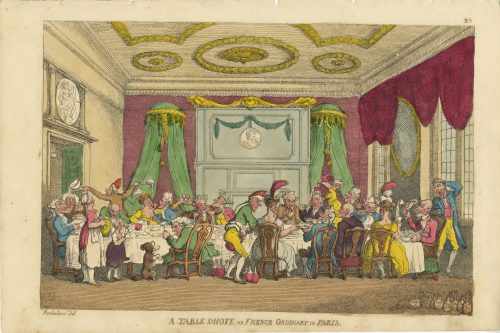 Hand-coloured etching by Thomas Rowlandson, printed on May 30, 1810, in London; № 20 from the series The Caricature Magazine or Hudibrastic Mirror Vol. 2. Description by Metropolitan Museum (59.533.978): "Guests of a dinner sit at a long narrow table in a magnificent room with an ornate ceiling. Two men and a young woman serve wine, one drawing a cork, the others spilling wine over the guests. Another waiter spills soup in an elderly guest's face. A woman and a little girl with a begging dog play tambourine and triangle at left." Inscribed in plate lower left: "Rowlandson Del."; bottom centre: "A TABLE DHOTE, OR FRENCH ORDINARY IN PARIS." Our copy is lacking the publication details: "Pub.d May 30. 1810 by Tho.s Tegg 111 Cheapside, London." and similar to the copy in Boston Public Library (18_03_000394). Dimensions: Sheet 27 x 40.5 cm; Image: 23.5 x 35 cm. Contributors: Thomas Rowlandson (British, 1756 – 1827) – artist. Thomas Tegg (British, 1776 – 1846) – publisher.
Hand-coloured etching by Thomas Rowlandson, printed on May 30, 1810, in London; № 20 from the series The Caricature Magazine or Hudibrastic Mirror Vol. 2. Description by Metropolitan Museum (59.533.978): "Guests of a dinner sit at a long narrow table in a magnificent room with an ornate ceiling. Two men and a young woman serve wine, one drawing a cork, the others spilling wine over the guests. Another waiter spills soup in an elderly guest's face. A woman and a little girl with a begging dog play tambourine and triangle at left." Inscribed in plate lower left: "Rowlandson Del."; bottom centre: "A TABLE DHOTE, OR FRENCH ORDINARY IN PARIS." Our copy is lacking the publication details: "Pub.d May 30. 1810 by Tho.s Tegg 111 Cheapside, London." and similar to the copy in Boston Public Library (18_03_000394). Dimensions: Sheet 27 x 40.5 cm; Image: 23.5 x 35 cm. Contributors: Thomas Rowlandson (British, 1756 – 1827) – artist. Thomas Tegg (British, 1776 – 1846) – publisher. -
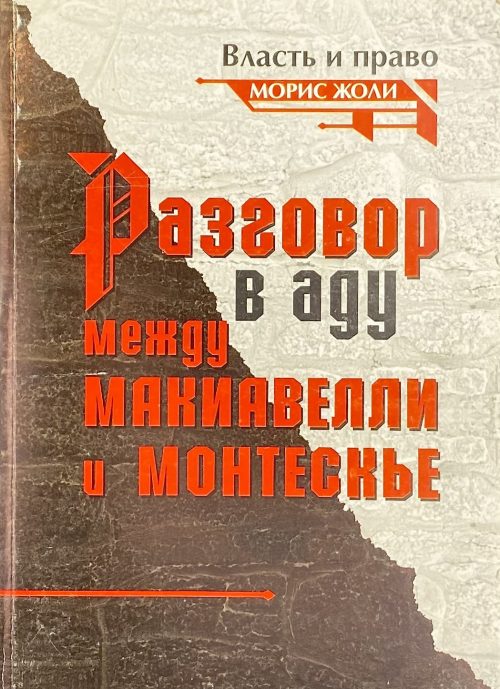 Description: Pictorial wrappers, black and grey with black and red lettering, blurb on the back. Title-page: Власть и право | МОРИС ЖОЛИ | Разговор | в аду | между | МАКИАВЕЛЛИ | и МОНТЕСКЬЕ | Санкт-Петербург | 2004 ||, front wrapper: same but without place and year. Pagination: [1-3] 4-231 [8 blank] [1 colophon], total 120 leaves. See original edition: LIB-1034.2016, LIB-2913.2021 and LIB-0460.2015. Other related objects: SVVP-0062.2021. This translation is made out of the German translation of the French original. The name of the translator is unknown. Contributors: Maurice Joly (French, 1829 – 1878)
Description: Pictorial wrappers, black and grey with black and red lettering, blurb on the back. Title-page: Власть и право | МОРИС ЖОЛИ | Разговор | в аду | между | МАКИАВЕЛЛИ | и МОНТЕСКЬЕ | Санкт-Петербург | 2004 ||, front wrapper: same but without place and year. Pagination: [1-3] 4-231 [8 blank] [1 colophon], total 120 leaves. See original edition: LIB-1034.2016, LIB-2913.2021 and LIB-0460.2015. Other related objects: SVVP-0062.2021. This translation is made out of the German translation of the French original. The name of the translator is unknown. Contributors: Maurice Joly (French, 1829 – 1878) -
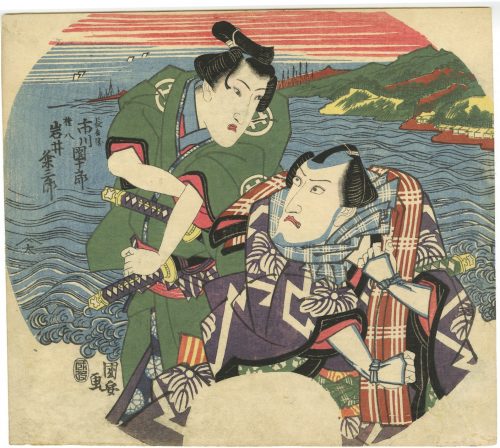 Artist: Utagawa Kuniyasu [歌川 国安] (Japanese, 1794–1832). Publisher seal: [太] (Ta): Marks 02-050 | U421b: An unknown publisher in Edo, fl. c. 1815-61; name assigned according to seal shape “Yama-Ta“. Signed: Kuniyasu ga [国安 画]. Date-aratame seal: Bunsei 9 (1826). Actors: Iwai Hanshirō VI [岩井半四郎] (Japanese, 1799 – 1836), other names: Iwai Hanshirō VI, Iwai Kumesaburō II, Iwai Hisajirō I, Baiga (poetry name), Shūka (poetry name) — as Shirai Gonpachi [白井權八]. Ichikawa Danjūrō VII 市川団十郎 (Japanese, 1791 – 1859), other names: Ichikawa Ebizō V, Ichikawa Hakuen II, Ichikawa Shinnosuke I — as Banzui Chōbei [幡随長兵衛]. Kabuki play: Suzugamori [Suzu-ga-Mori, 鈴ヶ森], a.k.a. Ukiyozuka Hiyoku no Inazuma written by Tsuruya Nanboku IV (Japanese, c. 1755 – 1829). First staged in 1823 at Ichimura-za [市村座] in Edo. Plot: "A gang of evil palanquin bearers are stationed near the Suzugamori execution grounds, where they lay in wait to rob travellers passing through. Gonpachi, who killed a man in his home province, is being sought by the police. He is fleeing to Edo when the bearers attack him in hopes of claiming a reward. He beats them off with great skill. Banzui Chōbei, who is being carried by in a palanquin, sees the attack, admires Gonpachi's ability, and promises to aid him if he is going to Edo". [Samuel L. Leiter. Historical Dictionary of Japanese Traditional Theatre. — Rowman & Littlefield, 2014; p. 382-3.; LIB-2110.2019]. Ref.: Sotheby's.
Artist: Utagawa Kuniyasu [歌川 国安] (Japanese, 1794–1832). Publisher seal: [太] (Ta): Marks 02-050 | U421b: An unknown publisher in Edo, fl. c. 1815-61; name assigned according to seal shape “Yama-Ta“. Signed: Kuniyasu ga [国安 画]. Date-aratame seal: Bunsei 9 (1826). Actors: Iwai Hanshirō VI [岩井半四郎] (Japanese, 1799 – 1836), other names: Iwai Hanshirō VI, Iwai Kumesaburō II, Iwai Hisajirō I, Baiga (poetry name), Shūka (poetry name) — as Shirai Gonpachi [白井權八]. Ichikawa Danjūrō VII 市川団十郎 (Japanese, 1791 – 1859), other names: Ichikawa Ebizō V, Ichikawa Hakuen II, Ichikawa Shinnosuke I — as Banzui Chōbei [幡随長兵衛]. Kabuki play: Suzugamori [Suzu-ga-Mori, 鈴ヶ森], a.k.a. Ukiyozuka Hiyoku no Inazuma written by Tsuruya Nanboku IV (Japanese, c. 1755 – 1829). First staged in 1823 at Ichimura-za [市村座] in Edo. Plot: "A gang of evil palanquin bearers are stationed near the Suzugamori execution grounds, where they lay in wait to rob travellers passing through. Gonpachi, who killed a man in his home province, is being sought by the police. He is fleeing to Edo when the bearers attack him in hopes of claiming a reward. He beats them off with great skill. Banzui Chōbei, who is being carried by in a palanquin, sees the attack, admires Gonpachi's ability, and promises to aid him if he is going to Edo". [Samuel L. Leiter. Historical Dictionary of Japanese Traditional Theatre. — Rowman & Littlefield, 2014; p. 382-3.; LIB-2110.2019]. Ref.: Sotheby's. -
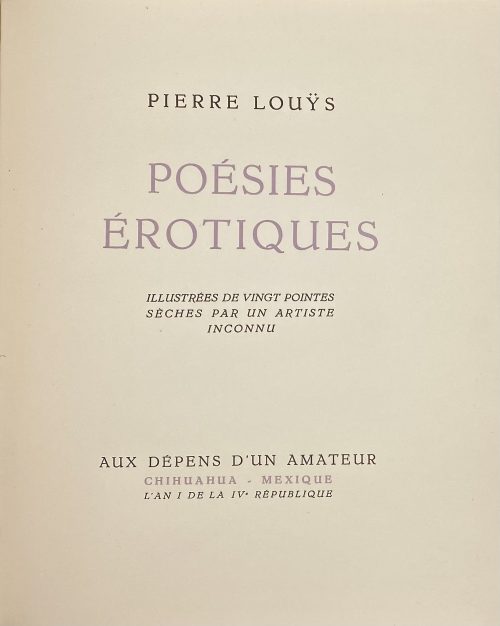 Description: one volume 28.5 x 23 cm in publisher’s French flapped wrappers, with lettering to front “Pierre Louÿs”, in glassine dust jacket, in tan cardboard double slipcase 29.7 x 24 cm with ticket “Haeusgen | 8 München 90 | Reinekestrasse 36”; 13 gatherings in-4to (52 leaves), unbound, with 20 drypoint illustrations by Louis Berthomme Saint-André, 15 of them full-page plates, with tissue guards, printed on wove paper watermarked “Lana 15‡90”, unpaginated. Title-page (black and purple): PIERRE LOUŸS | POÉSIES | ÉROTIQUES | ILLUSTRÉES DE VINGT POINTES | SÈCHES PAR ARTISTE | INCONNU | AUX DÉPENS D’UN AMATEUR | CHIHUAHUA ~ MEXIQUE | L’AN I DE LA IVe RÉPUBLIQUE || Limitation (colophon): total print run of 350 copies on Lana paper, of which 20 copies marked A-T with an original drawing, etc. enriched; 30 copies numbered I-XXX, and 300 numbered 1-300. This is copy № 295. Catalogue raisonné: Dutel (1920-1970) № 2231, p. 324; Nordmann-Christie’s (2): № 322, p. 157. Contributors: Pierre Louÿs (French, 1870 – 1925) – author. Louis Berthomme Saint-André (French, 1905 – 1977) – artist.
Description: one volume 28.5 x 23 cm in publisher’s French flapped wrappers, with lettering to front “Pierre Louÿs”, in glassine dust jacket, in tan cardboard double slipcase 29.7 x 24 cm with ticket “Haeusgen | 8 München 90 | Reinekestrasse 36”; 13 gatherings in-4to (52 leaves), unbound, with 20 drypoint illustrations by Louis Berthomme Saint-André, 15 of them full-page plates, with tissue guards, printed on wove paper watermarked “Lana 15‡90”, unpaginated. Title-page (black and purple): PIERRE LOUŸS | POÉSIES | ÉROTIQUES | ILLUSTRÉES DE VINGT POINTES | SÈCHES PAR ARTISTE | INCONNU | AUX DÉPENS D’UN AMATEUR | CHIHUAHUA ~ MEXIQUE | L’AN I DE LA IVe RÉPUBLIQUE || Limitation (colophon): total print run of 350 copies on Lana paper, of which 20 copies marked A-T with an original drawing, etc. enriched; 30 copies numbered I-XXX, and 300 numbered 1-300. This is copy № 295. Catalogue raisonné: Dutel (1920-1970) № 2231, p. 324; Nordmann-Christie’s (2): № 322, p. 157. Contributors: Pierre Louÿs (French, 1870 – 1925) – author. Louis Berthomme Saint-André (French, 1905 – 1977) – artist. -
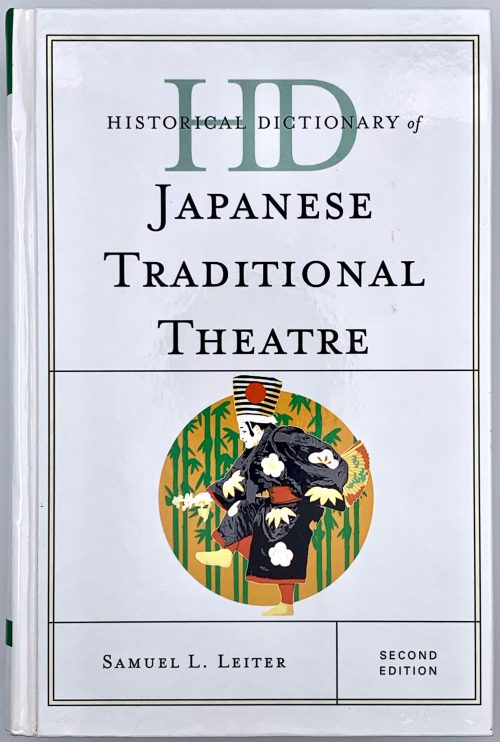 One volume 23.5 x 16 x 6 cm, with glossy pictorial boards lettered to front, back and spine; pp.: [i-viii] ix-xlviii 1-766, total 407 leaves, with b/w illustrations. Title-page: Historical Dictionary of | Japanese Traditional Theatre | Second Edition | Samuel L. Leiter | ROWMAN & LITTLEFIELD | Lanham • Boulder • New York • London || ISBN: 9781442239104. Author: Samuel L. Leiter (American, b. 1940)
One volume 23.5 x 16 x 6 cm, with glossy pictorial boards lettered to front, back and spine; pp.: [i-viii] ix-xlviii 1-766, total 407 leaves, with b/w illustrations. Title-page: Historical Dictionary of | Japanese Traditional Theatre | Second Edition | Samuel L. Leiter | ROWMAN & LITTLEFIELD | Lanham • Boulder • New York • London || ISBN: 9781442239104. Author: Samuel L. Leiter (American, b. 1940) -
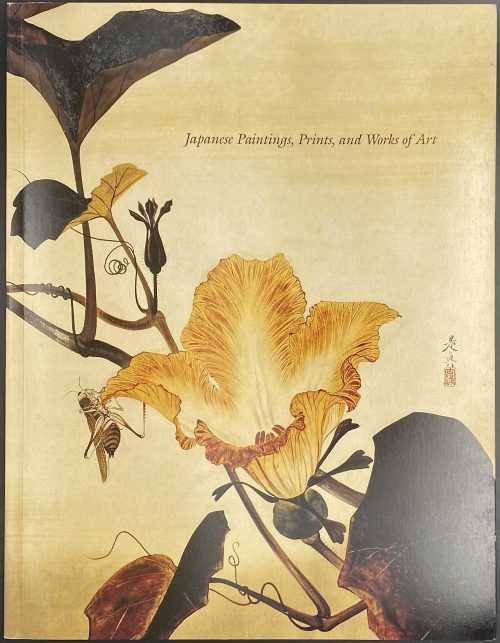 Softcover, in flapped pictorial wrappers, 28 x 21.7 cm, 16 entries, with colour illustrations. Catalogue # 5 of the sales exhibition on September 17-22, 2001 in NY; pagination: [1-3] 4-33 [3], ils. Contributor: Sebastian Izzard
Softcover, in flapped pictorial wrappers, 28 x 21.7 cm, 16 entries, with colour illustrations. Catalogue # 5 of the sales exhibition on September 17-22, 2001 in NY; pagination: [1-3] 4-33 [3], ils. Contributor: Sebastian Izzard -
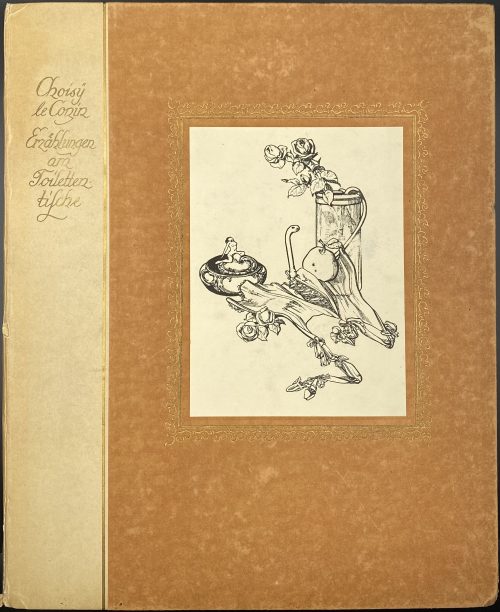 Publisher's flapped portfolio 32.8 x 26.8 cm, gilt-ruled and gilt-lettered quarter faux-parchment waxed paper over brown paper boards with pasted illustration after von Bayros within gilt arabesque frame. Possibly published in Vienna by Heinrich Conrad in 1905 or 1908. The portfolio contains the title page with a vignette and 15 loose wove paper sheets 32 x 26.2 cm of collotype reproductions after drawings by Franz von Bayros. Cover gilt lettering: Choisÿ | le Conin | Erzählungen | am | Toiletten- | tische || Title-page: Erzählungen | am Toilettentische | von | CHOISY LE CONIN | {vignette} || Title-page verso: Inhalt: | 1. Die Tabaksdose | 2. Viola de Gamba | 3. Der Bote | 4. Nicht drängeln, Kinder! | 5. Die blaue Feder | 6. O what a pretty like-place! | 7. Die Sonnenuhr |8. Der Temel der der Cotÿs | 9. Der Fetischist | 10. Jupiter und Europa | 11. Die Witwe | 12. Paroxÿsme-erotique | 13. Der Rivale | 14. Die rote Lehrerin | 15. Tantalus | Nicht im Handel. || Catalogue raisonné: The amorous drawings of the Marquis von Bayros / Part I and II. — NY: Cythera Press, 1968; pp. 95-111 [LIB-2246.2019]
Publisher's flapped portfolio 32.8 x 26.8 cm, gilt-ruled and gilt-lettered quarter faux-parchment waxed paper over brown paper boards with pasted illustration after von Bayros within gilt arabesque frame. Possibly published in Vienna by Heinrich Conrad in 1905 or 1908. The portfolio contains the title page with a vignette and 15 loose wove paper sheets 32 x 26.2 cm of collotype reproductions after drawings by Franz von Bayros. Cover gilt lettering: Choisÿ | le Conin | Erzählungen | am | Toiletten- | tische || Title-page: Erzählungen | am Toilettentische | von | CHOISY LE CONIN | {vignette} || Title-page verso: Inhalt: | 1. Die Tabaksdose | 2. Viola de Gamba | 3. Der Bote | 4. Nicht drängeln, Kinder! | 5. Die blaue Feder | 6. O what a pretty like-place! | 7. Die Sonnenuhr |8. Der Temel der der Cotÿs | 9. Der Fetischist | 10. Jupiter und Europa | 11. Die Witwe | 12. Paroxÿsme-erotique | 13. Der Rivale | 14. Die rote Lehrerin | 15. Tantalus | Nicht im Handel. || Catalogue raisonné: The amorous drawings of the Marquis von Bayros / Part I and II. — NY: Cythera Press, 1968; pp. 95-111 [LIB-2246.2019] -
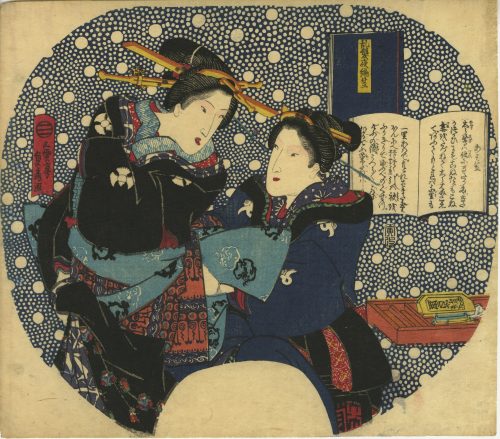 Artist: Utagawa Sadahide [歌川 貞秀], a.k.a. Gountei Sadahide [五雲亭 貞秀] (1807 – c. 1878/9). Signed: Gountei Sadahide ga [五雲亭貞秀画] Pubisher: Ibaya Senzaburō [伊場屋仙三郎] (Japanese, 1815 – 1869) Date-aratame seal: Bunsei 13 / Tenpō 1 (1830). Ref: Ritsumeikan University # Z0172-587. Title: Tangled Hair and the Evening Braided Hat [乱髪夜編笠] (Midaregami Yoru no Amigasa). The open book starts with the chapter title that reads Amigasa. This play was performed together with Kisohajime Hatsugai Soga [着衣始]初買曽我]. See the playbill for the performance at Moritaza at MFA (Boston) № 11.27208. 乱髪夜編笠(みだれがみよるのあみがさ。「夜の編笠」「白さぎ」
Artist: Utagawa Sadahide [歌川 貞秀], a.k.a. Gountei Sadahide [五雲亭 貞秀] (1807 – c. 1878/9). Signed: Gountei Sadahide ga [五雲亭貞秀画] Pubisher: Ibaya Senzaburō [伊場屋仙三郎] (Japanese, 1815 – 1869) Date-aratame seal: Bunsei 13 / Tenpō 1 (1830). Ref: Ritsumeikan University # Z0172-587. Title: Tangled Hair and the Evening Braided Hat [乱髪夜編笠] (Midaregami Yoru no Amigasa). The open book starts with the chapter title that reads Amigasa. This play was performed together with Kisohajime Hatsugai Soga [着衣始]初買曽我]. See the playbill for the performance at Moritaza at MFA (Boston) № 11.27208. 乱髪夜編笠(みだれがみよるのあみがさ。「夜の編笠」「白さぎ」とも)– one of the main melodies in katōbushi (河東節) type of jōruri [浄瑠璃]. For a detailed explanation in Japanese, see also HERE). A series of three prints is dedicated to a katōbushi performance of the Soga-themed plays.
They all have a background of hail patterns (Arare-ko-mon) [霰小紋], similar to Kunisada’s Iwai Kumesaburō II as An no Heibei [SVJP-0304.2019], see below.Yukari no Edo-zakura The tatami night robe of Iwao Tangled Hair and the Evening Braided Hat 
-
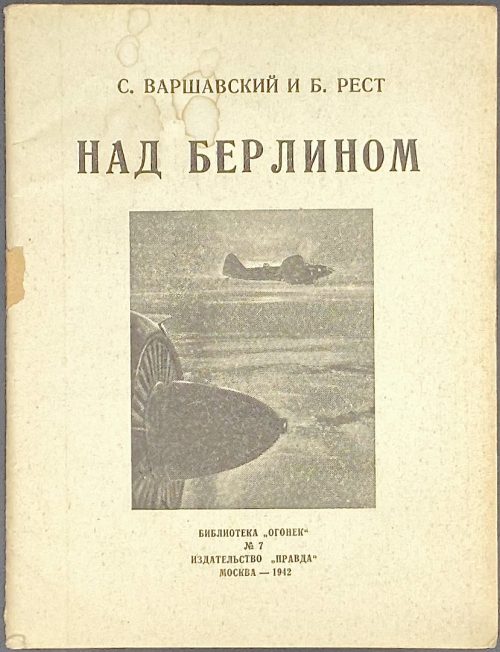 Сборник из семи рассказов: Карты на Запад; Ответственное задание; Старт на Берлин; Корабли идут над морем; «Боевой! Так держать!»; Второй удар; Благодарит Сталин. Two identical copies LIB-3028.2022(1) and LIB-3028.2022(2). Front wrapper: C. ВАРШАВСКИЙ И Б. РЕСТ | НАД БЕРЛИНОМ | {PHOTO} | БИБЛИОТЕКА “ОГОНЕК” | №7 | ИЗДАТЕЛЬСТВО “ПРАВДА” | МОСКВА — 1942 || Title-page: C. ВАРШАВСКИЙ и Б. РЕСТ | НАД БЕРЛИНОМ | Издательство “Правда” | Москва – 1942 || Description: Brochure, 14.7 x 10.9 cm, wrappers photo vignette and black lettering, pp.: [2] 3-37 [3], total 40 pages. Print run: 150.000 copies. Contributors: Sergei Petrovich Varshavsky [Сергей Петрович Варшавский] (Jewish-Russian, 1906 – 1980). B. Rest [Б. Рест; Юлий Исаакович Шапиро] (Jewish-Russian, fl. 1940 – 1980).
Сборник из семи рассказов: Карты на Запад; Ответственное задание; Старт на Берлин; Корабли идут над морем; «Боевой! Так держать!»; Второй удар; Благодарит Сталин. Two identical copies LIB-3028.2022(1) and LIB-3028.2022(2). Front wrapper: C. ВАРШАВСКИЙ И Б. РЕСТ | НАД БЕРЛИНОМ | {PHOTO} | БИБЛИОТЕКА “ОГОНЕК” | №7 | ИЗДАТЕЛЬСТВО “ПРАВДА” | МОСКВА — 1942 || Title-page: C. ВАРШАВСКИЙ и Б. РЕСТ | НАД БЕРЛИНОМ | Издательство “Правда” | Москва – 1942 || Description: Brochure, 14.7 x 10.9 cm, wrappers photo vignette and black lettering, pp.: [2] 3-37 [3], total 40 pages. Print run: 150.000 copies. Contributors: Sergei Petrovich Varshavsky [Сергей Петрович Варшавский] (Jewish-Russian, 1906 – 1980). B. Rest [Б. Рест; Юлий Исаакович Шапиро] (Jewish-Russian, fl. 1940 – 1980).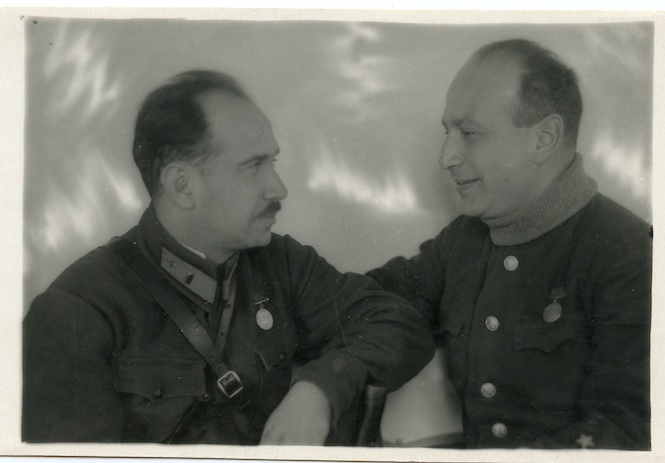
-
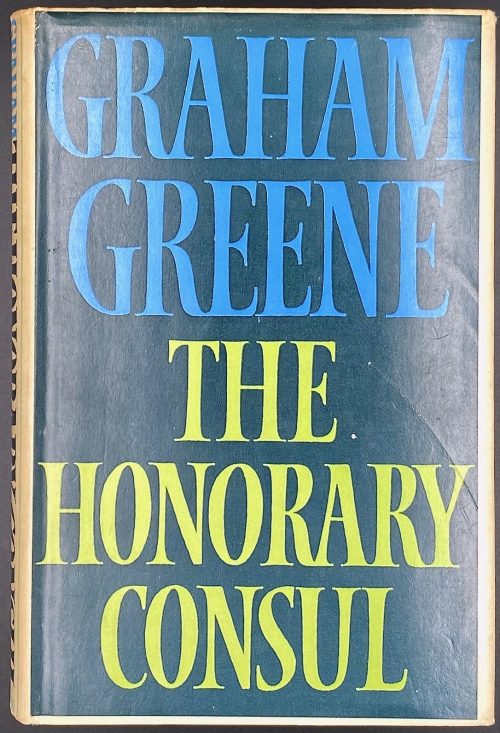 Hardcover, 20.2 x 13.6 cm, green cloth, gilt lettering to spine, in unclipped dust jacket, pp.: [1-8] 9-334 [2]. Title-page: THE HONORARY CONSUL | GRAHAM GREENE | {4 line citation} | {publisher’s device} | THE BODLEY HEAD | LONDON SYDNEY | TORONTO || © Graham Greene 1973. Printed by: William Clowes & Sons Ltd. (Beccles). Graham Greene (British, 1904 – 1991).
Hardcover, 20.2 x 13.6 cm, green cloth, gilt lettering to spine, in unclipped dust jacket, pp.: [1-8] 9-334 [2]. Title-page: THE HONORARY CONSUL | GRAHAM GREENE | {4 line citation} | {publisher’s device} | THE BODLEY HEAD | LONDON SYDNEY | TORONTO || © Graham Greene 1973. Printed by: William Clowes & Sons Ltd. (Beccles). Graham Greene (British, 1904 – 1991). -
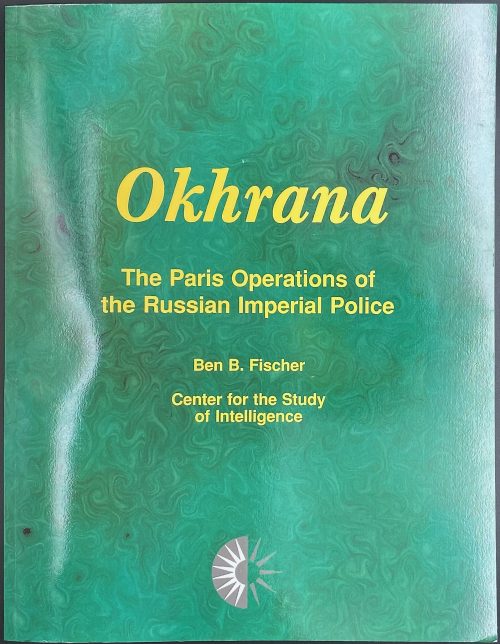 Paperback reprint on demand, 28 x 22 cm, in green malachite wrappers with yellow lettering to both covers; pp. [i-ii] iii-v[vi] 1-122 [4]. Title-page: Okhrana | The Paris Operations of | the Russian Imperial Police | Ben B. Fischer | History Staff | Center for the Study | of Intelligence | Central Intelligence Agency | 1997 || ISBN-10: 1907521992 Benjamin B. Fischer Contents. Foreword. Preface. Okhrana: The Paris Operations of the Russian Imperial Police. From Paris to Palo Alto. CIA Interest in the Okhrana Files. Origins of the Okhrana and Its Paris Office. Foreign Operations. Change and Continuity Dramatis Personae Conclusions Rita T. Kronenbitter Paris Okhrana 1885-1905. The Illustrious Career of Arkadiy Harting. The Sherlock Holmes of the Revolution. Okhrana Agent Dolin. The Okhrana's Female Agents: Part I: Russian Women. The Okhrana's Female Agents: Part II: Indigenous Recruits. Review of Edward Ellis Smith, The Young Stalin, by Harry Gelman. Commentary by Rita T. Kronenbitter.
Paperback reprint on demand, 28 x 22 cm, in green malachite wrappers with yellow lettering to both covers; pp. [i-ii] iii-v[vi] 1-122 [4]. Title-page: Okhrana | The Paris Operations of | the Russian Imperial Police | Ben B. Fischer | History Staff | Center for the Study | of Intelligence | Central Intelligence Agency | 1997 || ISBN-10: 1907521992 Benjamin B. Fischer Contents. Foreword. Preface. Okhrana: The Paris Operations of the Russian Imperial Police. From Paris to Palo Alto. CIA Interest in the Okhrana Files. Origins of the Okhrana and Its Paris Office. Foreign Operations. Change and Continuity Dramatis Personae Conclusions Rita T. Kronenbitter Paris Okhrana 1885-1905. The Illustrious Career of Arkadiy Harting. The Sherlock Holmes of the Revolution. Okhrana Agent Dolin. The Okhrana's Female Agents: Part I: Russian Women. The Okhrana's Female Agents: Part II: Indigenous Recruits. Review of Edward Ellis Smith, The Young Stalin, by Harry Gelman. Commentary by Rita T. Kronenbitter. -
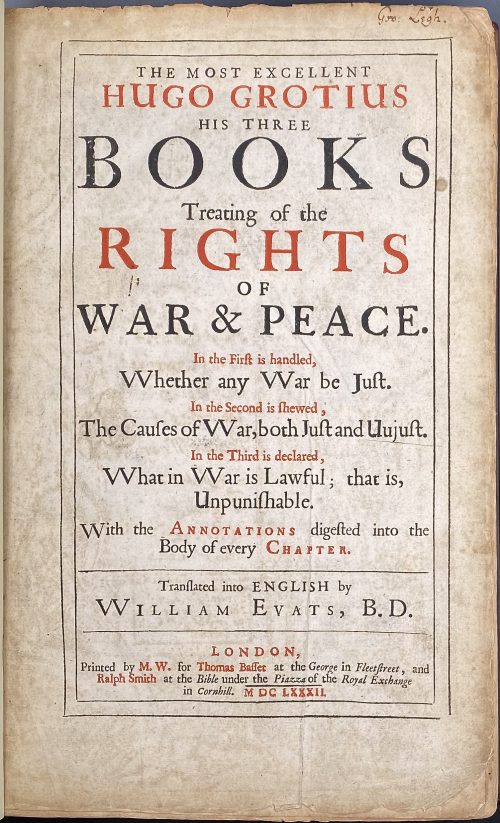 Volume collated 4to, 32.5 x 21 cm, later full calf, blind-tooled boards, sunned, raised bands and gilt lettering to spine. bound without the additional engraved title-page sometimes present; title printed in black and red, woodcut headpieces and initials; a little foxing (mostly marginal) throughout, title lightly dust stained with slight chipping at extremities, minor marginal worming to early leaves (b3-I4), paper flaw to outer margin of E1; contemporary English ownership inscription of George Legh to the title, a handful of manuscript corrections to text and annotations to index. Title-page (double frame, red and black, tall ‘s’): THE MOST EXCELLENT | HUGO GROTIUS | HIS THREE | BOOKS | Treating of the | RIGHTS | OF | WAR & PEACE. | In the First is handled, | Whether any War be Just. | In the Second is shewed , | The Causes of War, both Just and Uujust (sic). | In the Third is declared , | What in War is Lawful ; that is, | Unpunishable. | With the Annotations digested into the | Body of every Chapter. | — | Translated into ENGLISH by | William Evats, B. D. | — | LONDON, | Printed by M. W. for Thomas Basset at the George in Fleetstreet, and | Ralph Smith at the Bible under the Piazza of the Royal Exchange | in Cornhill. M DC LXXXII. || Collation: A4 a-b4 c3 B-Z4 2A-2D4 2E6 3A-3Z4 4A-4D4 4E-4L2; total 247 leaves as called for; lacking engraved title-page. Pagination: [4] i-xxi [5] 1-220 (text continuous) 361-572 [573] [574 blank] [30 table]; total 494 pages. Seller’s note: First edition of the first complete English translation, following Barksdale’s abridgement, of Grotius’s landmark work of political philosophy, the first treatise on international law. First published in Latin in 1625, Grotius’s De iure belli ac pacis “became the basic manual for both the theoretical justification and the entire practice of the international law of war as well as of international law in general for the whole period of the ancien régime in Europe” [Duchhardt, p. 288]. “It would be hard to imagine any work more central to the intellectual world of the Enlightenment … [By] the time of the post-First World War settlement, Grotius was regarded almost exclusively as the founder of modern civilized interstate relations, and as a suitable tutelary presence for the new Peace Palace at The Hague … [In] some ways that was to radically misunderstand Grotius’s views on war; he was in fact much more of an apologist for aggression and violence than many of his more genuinely innovative qualities of his moral theory, qualities that entitle him to an essential place in the history of political theory …” [Tuck, pp. xi-xii]. Contributors: Hugo Grotius (Dutch, 1583 – 1645) – author. William Evats (British, c.1606 – 1677) – translator. Margaret White (British, fl. 1678 – 1683) – printer. Thomas Bassett (British, fl. c. 1659 – 1693) – publisher/bookseller. Ralph Smith (British, fl. 1642 – 1684) – publisher/bookseller.
Volume collated 4to, 32.5 x 21 cm, later full calf, blind-tooled boards, sunned, raised bands and gilt lettering to spine. bound without the additional engraved title-page sometimes present; title printed in black and red, woodcut headpieces and initials; a little foxing (mostly marginal) throughout, title lightly dust stained with slight chipping at extremities, minor marginal worming to early leaves (b3-I4), paper flaw to outer margin of E1; contemporary English ownership inscription of George Legh to the title, a handful of manuscript corrections to text and annotations to index. Title-page (double frame, red and black, tall ‘s’): THE MOST EXCELLENT | HUGO GROTIUS | HIS THREE | BOOKS | Treating of the | RIGHTS | OF | WAR & PEACE. | In the First is handled, | Whether any War be Just. | In the Second is shewed , | The Causes of War, both Just and Uujust (sic). | In the Third is declared , | What in War is Lawful ; that is, | Unpunishable. | With the Annotations digested into the | Body of every Chapter. | — | Translated into ENGLISH by | William Evats, B. D. | — | LONDON, | Printed by M. W. for Thomas Basset at the George in Fleetstreet, and | Ralph Smith at the Bible under the Piazza of the Royal Exchange | in Cornhill. M DC LXXXII. || Collation: A4 a-b4 c3 B-Z4 2A-2D4 2E6 3A-3Z4 4A-4D4 4E-4L2; total 247 leaves as called for; lacking engraved title-page. Pagination: [4] i-xxi [5] 1-220 (text continuous) 361-572 [573] [574 blank] [30 table]; total 494 pages. Seller’s note: First edition of the first complete English translation, following Barksdale’s abridgement, of Grotius’s landmark work of political philosophy, the first treatise on international law. First published in Latin in 1625, Grotius’s De iure belli ac pacis “became the basic manual for both the theoretical justification and the entire practice of the international law of war as well as of international law in general for the whole period of the ancien régime in Europe” [Duchhardt, p. 288]. “It would be hard to imagine any work more central to the intellectual world of the Enlightenment … [By] the time of the post-First World War settlement, Grotius was regarded almost exclusively as the founder of modern civilized interstate relations, and as a suitable tutelary presence for the new Peace Palace at The Hague … [In] some ways that was to radically misunderstand Grotius’s views on war; he was in fact much more of an apologist for aggression and violence than many of his more genuinely innovative qualities of his moral theory, qualities that entitle him to an essential place in the history of political theory …” [Tuck, pp. xi-xii]. Contributors: Hugo Grotius (Dutch, 1583 – 1645) – author. William Evats (British, c.1606 – 1677) – translator. Margaret White (British, fl. 1678 – 1683) – printer. Thomas Bassett (British, fl. c. 1659 – 1693) – publisher/bookseller. Ralph Smith (British, fl. 1642 – 1684) – publisher/bookseller. -
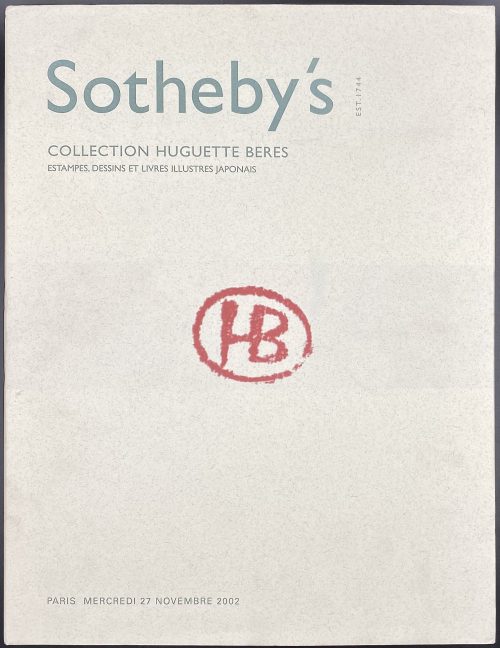 Two paperback volumes, 29.6 x 22.8 cm, pictorial softcover in full dust jacket with letering (see below); One the back DJ of both volumes lettered: “Sotheby’s | EST. 1744 (vertical) | GALERIE CHARPENTIER 76 RUE DE FAUBOURG SAINT-HONORÉ 75008 PARIS WWW. SOTHEBYS.COM”. Vol. 1: DJ lettered in olive green: Sotheby’s | EST. 1744 (vertical) | COLLECTION HUGUETTE BERES | ESTAMPES, DESSINS ET LIVRES ILLUSTRES JAPONAIS | {HB monogram in red} | PARIS MERCREDI 27 NOVEMBRE 2002 ||. Pagination: 2 ffl, [1-5] (h.t., t.p., Sommaire), 6-340, 2 ffl; 229 lots with ils.; sale PF2021 Vol. 2: DJ lettered in olive green: “Sotheby’s | EST. 1744 (vertical) | COLLECTION HUGUETTE BERES | ESTAMPES, DESSINS ET LIVRES ILLUSTRES JAPONAIS (SECONDE VENTE) | {HB monogram in red} | PARIS MARDI 25 novembre 2003 ||. Pagination: 2 ffl, [1-7] (h.t., t.p., Sommaire, f.t.) 8-287 [288 blank], 2 ffl; 252 lots with ils.; sale PF3018. Contributors: Huguette Berès (French, 1913 – 1999)
Two paperback volumes, 29.6 x 22.8 cm, pictorial softcover in full dust jacket with letering (see below); One the back DJ of both volumes lettered: “Sotheby’s | EST. 1744 (vertical) | GALERIE CHARPENTIER 76 RUE DE FAUBOURG SAINT-HONORÉ 75008 PARIS WWW. SOTHEBYS.COM”. Vol. 1: DJ lettered in olive green: Sotheby’s | EST. 1744 (vertical) | COLLECTION HUGUETTE BERES | ESTAMPES, DESSINS ET LIVRES ILLUSTRES JAPONAIS | {HB monogram in red} | PARIS MERCREDI 27 NOVEMBRE 2002 ||. Pagination: 2 ffl, [1-5] (h.t., t.p., Sommaire), 6-340, 2 ffl; 229 lots with ils.; sale PF2021 Vol. 2: DJ lettered in olive green: “Sotheby’s | EST. 1744 (vertical) | COLLECTION HUGUETTE BERES | ESTAMPES, DESSINS ET LIVRES ILLUSTRES JAPONAIS (SECONDE VENTE) | {HB monogram in red} | PARIS MARDI 25 novembre 2003 ||. Pagination: 2 ffl, [1-7] (h.t., t.p., Sommaire, f.t.) 8-287 [288 blank], 2 ffl; 252 lots with ils.; sale PF3018. Contributors: Huguette Berès (French, 1913 – 1999) -
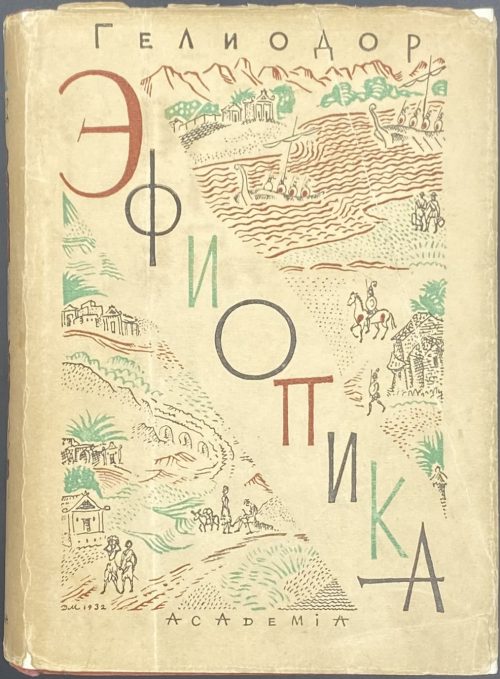 Hardcover volume, 18 x 13 cm, bound in purple cloth with stamped design to boards and spine, lettering to spine, pictorial dust jacket, pictorial endpapers, pp.: [1-9] 10-491 [5], collated in 8vo: [1]-[31]8, 248 leaves (496 pages); covers, endpapers, DJ, head- and tailpieces, vignettes on the frontispiece, title-page, and faux-titles after Dmitry Mitrohin; text in Russian. Frontispiece (black and grey): СОКРОВИЩА | МИРОВОЙ | ЛИТЕРАТУРЫ | ГЕЛИОДОР | ЭФИОПИКА | {vignette} | ACADEMIA | МОСКВА ЛЕНИНГРАД | 1932 || Title-page: ГЕЛИОДОР | ЭФИОПИКА | ВСТУПИТЕЛЬНАЯ | СТАТЬЯ | РЕДАКЦИЯ | ПЕРЕВОДА | И | ПРИМЕЧАНИЯ | А. ЕГУНОВА | {vignette} | ACADEMIA | МОСКВА ЛЕНИНГРАД | 1932 || Title verso: ΗΛΙΟΔΩΡΟΥ | ΑΙΘΙΟΠΙΚΩΝ | ΒΙΒΛΙΑ | ΔΕΚΑ | Орнаментация книги | Д. И. Митрохина || Contributors: Heliodorus Emesenus [Ηλιόδωρος ο Εμεσηνός] (Greek, 3-4 century AD) – author. Андрей Николаевич Егунов (Russian, 1895 – 1968) – editor, author. Дмитрий Исидорович Митрохин [Dmitry Mitrohin] (Russian, 1883 – 1973) – artist. For French translation, see LIB-3027.2022.
Hardcover volume, 18 x 13 cm, bound in purple cloth with stamped design to boards and spine, lettering to spine, pictorial dust jacket, pictorial endpapers, pp.: [1-9] 10-491 [5], collated in 8vo: [1]-[31]8, 248 leaves (496 pages); covers, endpapers, DJ, head- and tailpieces, vignettes on the frontispiece, title-page, and faux-titles after Dmitry Mitrohin; text in Russian. Frontispiece (black and grey): СОКРОВИЩА | МИРОВОЙ | ЛИТЕРАТУРЫ | ГЕЛИОДОР | ЭФИОПИКА | {vignette} | ACADEMIA | МОСКВА ЛЕНИНГРАД | 1932 || Title-page: ГЕЛИОДОР | ЭФИОПИКА | ВСТУПИТЕЛЬНАЯ | СТАТЬЯ | РЕДАКЦИЯ | ПЕРЕВОДА | И | ПРИМЕЧАНИЯ | А. ЕГУНОВА | {vignette} | ACADEMIA | МОСКВА ЛЕНИНГРАД | 1932 || Title verso: ΗΛΙΟΔΩΡΟΥ | ΑΙΘΙΟΠΙΚΩΝ | ΒΙΒΛΙΑ | ΔΕΚΑ | Орнаментация книги | Д. И. Митрохина || Contributors: Heliodorus Emesenus [Ηλιόδωρος ο Εμεσηνός] (Greek, 3-4 century AD) – author. Андрей Николаевич Егунов (Russian, 1895 – 1968) – editor, author. Дмитрий Исидорович Митрохин [Dmitry Mitrohin] (Russian, 1883 – 1973) – artist. For French translation, see LIB-3027.2022.





